Karl Shuker's Blog, page 2
December 31, 2024
TONGUE-TIED BY THE TWO-TONGUES!
 Is this what Malaya'smystifying two-tongued cryptids looked like? (created by me using Grok)
Is this what Malaya'smystifying two-tongued cryptids looked like? (created by me using Grok)The days spanningChristmas and the New Year are traditionally ones filled with mystery andmagic, a time of weirdness and wonder. So what better day than today, NewYear's Eve, to present here on ShukerNature for your entertainment and enjoyumentduring this time the following cryptozoological conundrum?
In 1997, I included the following account in my book FromFlying Toads To Snakes With Wings, hoping thatsomeone reading it might be able to propose an identity for the mysteriouscreatures described, as I was thoroughly perplexed by them – but no-one everdid. Consequently, I can only assume that these cryptids left them astaxonomically tongue-tied as they have done with me. Nor have I ever uncoveredany additional information concerning them. So, 26 years later, in 2023, Ireprinted my account in my regular Alien Zoo column on mystery animals andanimal mysteries for the British magazine ForteanTimes as a fascinating crypto-riddle to ponder over during the festiveseason, just in case it did elicit a solution from someone that time. Onceagain, however, answer came there none.
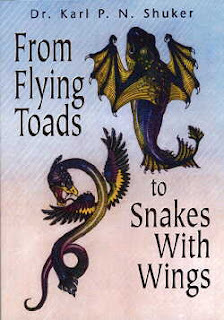 My book
FromFlying Toads To Snakes With Wings
(© Dr Karl Shuker/Llewellyn Publications)
My book
FromFlying Toads To Snakes With Wings
(© Dr Karl Shuker/Llewellyn Publications)
Consequently, one yearon from its appearance in Alien Zoo, and in the hope that the familiar phrase""third time lucky" will indeed prove true on this occasion,here yet again is the my account recalling the tangled tale of the two-tongues,in case ShukerNature's redoubtable readers can provide the long-sought key toits locked box of beastly secrets:
On May 271939, Modern Wonder documented some 'ultra-mysterious' mammals,allegedly captured by a photographer in the Malayan jungles and later observedby bemused officials in Manila, in the Philippines. Each of the beasts (ofunrecorded number) was described as being quadrupedal, weighing about 200pounds, covered in a furry, mole-like pelage (i.e. dark, dense, and shiny?),with a raccoon-like head [masked?], a pair of owl-like eyes (thus large andstaring?), and odd dentition - some of its teeth resembled a man's, others werecat-like – plus a fondness for bananas. Except for their extremely heavy weight(an error on the part of the original report?), there would seem to be a chanceof identifying them with some known animal type – until, that is, their mostdistinctive characteristic is revealed.
For thedescription also stated that each of these beasts had two tongues! Furthermore,it alleged that they never drank, because they absorbed all of the moisturethat they required directly through their skins. This is generally a feature ofcertain animals living in water or in moist habitats, but the animals concernedare normally amphibians, fishes, and lower life forms, not mammals. Conversely,it is true that many desert-dwelling rodents rarely if ever drink water,because they obtain it from their food (e.g. juicy plant tissues) or frommetabolic water released as they digest the dry components of their diet, butthey do not absorb water through their skins.
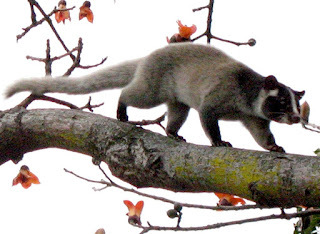 Masked palm civet Paguma larvata, native to Peninsular Malaysia, named after its raccoon-likefacial mask (© Denise Chan/Wikipedia –
CC BY-SA 2.0 licence)
Masked palm civet Paguma larvata, native to Peninsular Malaysia, named after its raccoon-likefacial mask (© Denise Chan/Wikipedia –
CC BY-SA 2.0 licence)
In generalappearance (and excluding weight), they are reminiscent of some of thelesser-known, mask-faced forms of Malay civet and badger – elusive,short-furred creatures of nocturnal lifestyle and partial to fruit within theirlargely omnivorous diet. Moreover, the owl-like eyes call to mind the tarsiers- those orb-eyed, sucker-fingered, lemur-like primates indigenous to southeastAsia (including the Malay Archipelago), and sufficiently strange in appearanceto those not familiar with these rarely-seen nocturnal creatures to attractsurprise and newspaper attention.
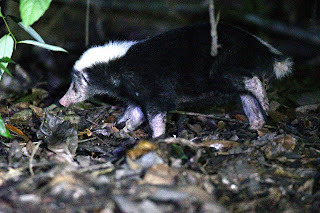 Sunda stink (=skunk) badger Mydaus javanensis, native to Indonesia andMalaysia, photographed in Malaysia (© Thompson Hyggen – copyright-free)
Sunda stink (=skunk) badger Mydaus javanensis, native to Indonesia andMalaysia, photographed in Malaysia (© Thompson Hyggen – copyright-free)
Even so,none of those identities can reconcile the mystery beasts' two tongues and theability to absorb moisture directly through their skins. Could these attributeshave been based upon misunderstanding or mistranslation, rather than uponreality? As nothing more is on record regarding the photographer's mystifyingfinds, there is no way of knowing.
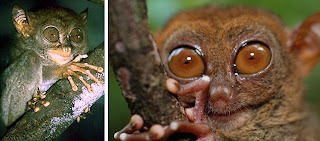 Tarsiers are nothing if not goblinesque, evenotherworldly, in appearance, especially to anyone unfamiliar with these curiousyet harmless creatures (© LDC Inc Foundation/Wikipedia –
CC BY-SA 3.0 licence
/ (© PieereFidenci/Wikipedia –
CC BY-SA 2.0 licence)
Tarsiers are nothing if not goblinesque, evenotherworldly, in appearance, especially to anyone unfamiliar with these curiousyet harmless creatures (© LDC Inc Foundation/Wikipedia –
CC BY-SA 3.0 licence
/ (© PieereFidenci/Wikipedia –
CC BY-SA 2.0 licence)
So there it is, theowl-eyed, twin-tongued, never-drinking plantain-eater – if nothing else (and confirming that I'm easily pleased!), it scanssatisfyingly like the one-eyed, one-horned, flying purple people eaterimmortalised in a classic 1958 Sheb Wooley novelty song and 30 years later in a1988 family movie directly inspired by it!
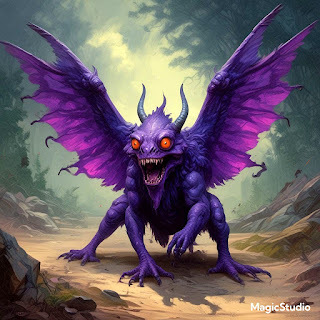 Failing abysmally in my attempts togenerate a one-eyed, one-horned, flying purple people eater, here's a two-eyed,two-horned flying purple people eater instead! (created by me usingMagicStudio)
Failing abysmally in my attempts togenerate a one-eyed, one-horned, flying purple people eater, here's a two-eyed,two-horned flying purple people eater instead! (created by me usingMagicStudio)
Meanwhile, any thoughts orsuggestions as to the two-tongues' possible identity, or any extra reports/informationregarding them, would be very gratefully received!
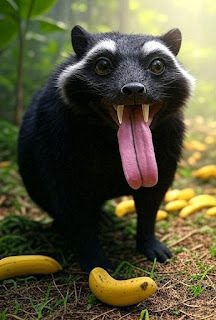 A two-tongue with a banquet of bananas awaitingits pleasure! (created by me using Grok)
A two-tongue with a banquet of bananas awaitingits pleasure! (created by me using Grok)
Incidentally, as someof you know, I've been experimenting with various AI image-generators, testingtheir capabilities and limitations so as to be better equipped to recogniseAI-generated fake cryptozoologically-themed images with which the Net seems tobe increasingly awash of late. So, as no image of the Malayan two-tongues hasever been created to my knowledge, I decided to put to the test two differentAI image-generators that I've been exploring, Grok and MagicStudio, and see howthey performed when prompted to produce pictures of these bizarre beasts.
And, as I'm sure thatthose out there who are not AI fans will be delighted to learn, both programswere aptly rendered tongue-tied (or whatever the AI equivalent state is!) bythe tortuous challenge posed by the two-tongues. Not only did they fail utterlyto depict them as the very sizeable animals that anything weighing 200 lb mustsurely be (instead presenting what look far more like diminutive cubs!), butalso, out of all the numerous images that they generated, only one, produced byGrok, actually featured creatures possessing two tongues apiece – and here itis:
 A pair of two-tongues actually depictedwith two tongues! (created by me using Grok)
A pair of two-tongues actually depictedwith two tongues! (created by me using Grok)
Overall, Grok was thesuperior creator with regard to this particular pictorial task, as it alsocreated a number of images featuring creatures with a single but bilobed tonguethat my own digital addition of a hand-drawn line separating the lobes into twoseparate tongues was sufficient to engender some satisfactory twin-tonguedentities that I've included in this article. Even so, they still did not overlyresemble the original 1977 verbal description of these creatures, quoted by meabove.
As for MagicStudio:usually a very accurate depicter of animals (give or take some extra ordeformed fingers/toes and the occasional additional leg, or two...): faced withproviding an accurate portrayal of the two-tongues, it threw a veritablegenerative gasket, and yielded some illustrations of animals that bore noresemblance whatsoever to the two-tongues' verbal description. It even garbledmy prompt for their tongues to be pink, bestowing upon its mixed-up mammals someportions of pink fur instead! However, albeit wholly inaccurate zoologically speaking,aesthetically some of the creatures thus created by MagicStudio were so attractive, appealing, and downright adorable that I couldn't bear to delete them. So here is a selection of them, in all oftheir delightful dottiness:

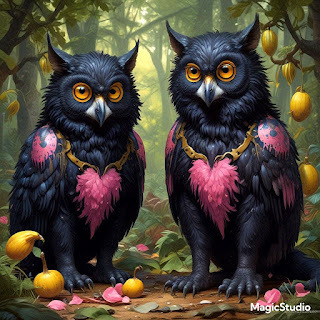
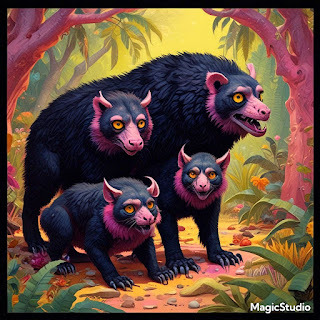 All three images created by me using MagicStudio
All three images created by me using MagicStudio
If nothing else,designers of prospective new cuddly toys could do a lot worse than be inspiredby some of these ultra-cute beasties. You can pay me my 10% creator'scommission later!
Today would have beenthe birthday of Nan, my maternal grandmother Gertrude Timmins (who onceexperienced a decidedly Fortean event of her own – click here to read all about it), whopassed away peacefully in her sleep at the grand old age of 99 back in 1994.Just like me, and also like her daughter, my mother Mary Shuker, Nan loved wildlifeand Nature in general, so I'm sure that she would have approved of my writingand presenting this fascinating fauna case here today on her birthday. Godbless you Nan, and Mom, and all of my family, all of whom are long gone now butnever forgotten by me. Ome day we shall be back together, never to be separatedagain.
 My late grandmother, Gertrude Timmins, withPatch, my little wire-haired Jack Russell terrier (© Dr Karl Shuker)
My late grandmother, Gertrude Timmins, withPatch, my little wire-haired Jack Russell terrier (© Dr Karl Shuker)
Wishing all of myShukerNature blog readers, and all of my Shuker In MovieLand blog readers too, a Happy NewYear – may 2025 prove to be a kindly, successful year for you.
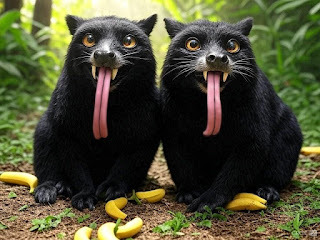 And it's toodle-pip from the two-tongues too!(created by me using Grok)
And it's toodle-pip from the two-tongues too!(created by me using Grok)
SEEKING THE SCIENCE BEHIND RAZORTOOTH AND FRANKENFISH!
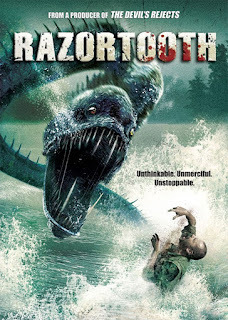 My official Lionsgate Region 1 DVD of Razortooth (© Patricia Harrington/Gravedigger Films/Capital ArtEntertainment (CAE)/PUSH/Lionsgate – reproduced here on a strictlynon-commercial Fair Use basis for educational/review purposes only)
My official Lionsgate Region 1 DVD of Razortooth (© Patricia Harrington/Gravedigger Films/Capital ArtEntertainment (CAE)/PUSH/Lionsgate – reproduced here on a strictlynon-commercial Fair Use basis for educational/review purposes only)Genetically-modified beasts, i.e. creaturesconverted from the mundane into the monstrous by mad scientists of the kind belovedby film audiences and directors alike for over a century now, have long been astaple theme in science fiction movies, and the two examples reviewed andmini-reviewed respectively here, both of which are of the piscean persuasion,are definitely no exception to this trend. So as 2024 winds down on this, its final day,why not wind down too by leisurely perusing these cinematic offerings originallypenned by me for my sister blog Shuker In MovieLand? Unless of course you're anichthyophobe, whereupon the time to look away is right now!
My movie watch almost exactlya year ago, on 20 December 2023, was my long-owned but previously-unviewed LionsgateRegion 1 DVD of Razortooth, in orderto find out at long last just how very far short this horror/monster moviewould fall in comparison to what I'd always naturally assumed was the extremevisual hyperbole of its DVD's ultra-dramatic front cover illustration (whichopens this present ShukerNature blog article) – only to discover to my greatsurprise that, if anything, the actual movie was even more OTT than saidillustration!!
Directed by PatriciaHarrington, and released in 2007 by CAE/PUSH, Razortooth is on the surface just another of those numerousmodern-day CGI-laden creature features in which a group of diverse people arebrought together in a shared spine-chilling experience of a horrific monster onthe rampage. The latter usually constitutes either a freakishly large orgenetically-altered mutant individual of a known present-day species or somegargantuan prehistoric horror retrieved from the distant past either directlyvia time-travel or once again via genetic manipulation.
Said monster thensystematically slaughters in a variety of different (but usually gory) meansvirtually every human character in the movie, steadily devouring its way up thecast list from bit-part players to supporting characters and then, finally,confronting the leads in a grand do-or-die climactic battle before expiringwith just enough screen time left for the surviving leads to exchange somelight banter before the credits roll.
In Razortooth, the titular monster is a genetically-modified Asianswamp eel (much more about which later) of huge size and voracious appetitethat has escaped into the Florida Everglades from the laboratory thatengineered it, and now is diligently decimating everything and everyone that itencounters there – escaped convicts, Irish wolfhound, teenage canoeists, theyall suffer the same gruesome fate, albeit executed in an array of imaginativesplatter fests. Incidentally, I should warn you that this particular moviecontains far more blood and gore than is usual for a low-budget modern-daycreature feature of the Syfy-similar genre, which is why it holds an R ratingcertificate in the States, so beware.
Normally at this point I'dpresent my own précis of the plot, but in this case the latter is so generic,and also because there is one particular aspect of the movie, a zoologicalaspect, that I'd much prefer devoting the majority of this review to (especiallyas it does not appear to have been covered by anyone else whose reviews I'veread), I've elected to save time and space by simply quoting instead a very succinct,accurate summary of it penned by Brazilian viewer Claudio Carvalho that Iencountered on IMDb's Razortooth entry,so here it is:
Two prisonersescape through the swamp land in Everglades and the search party is attacked bya giant mutant eel and is considered missing. The Animal Control agent DelmarCoates is searching [for] a missing dog with his ex-wife Sheriff RuthGainey-Coates and he discovers the remains of the animal. Meanwhile members ofa canoe club organize an expedition through the swamp. When Sheriff Ruthorganizes a manhunt to capture the criminals, Delmar informs that his formerfriend, Dr. Soren Abramson, who is chasing the eel with a group of collegestudents, is the [person] responsible for [this] mutant species [sic –specimen]. Sheriff Ruth organizes two teams to hunt the prisoners and the eel.
The two lead characters areDelmar Coates (played by Doug Swander) and Sheriff Ruth Gainey-Coates (KathleenLaGue), so it will come as no surprise to learn that they are still standing,just about, by the time that we reach this movie's big, explosive finish – andI do mean big, and explosive!! What may indeed come as a surprise, conversely,is spotting a familiar face playing one of the lesser characters – yes indeed,Josh Gad (playing ill-fated Jay Wells), in one of his earliest big-screen rolesbefore going on to the likes of Pixelswith Adam Sandler, Disney's live-action Beautyand the Beast, and the voice of Olaf the snowman in Frozen, among many others.
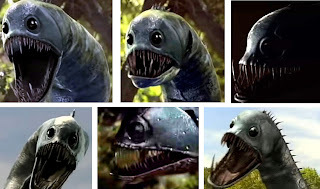 Eyeballing the razortooth: not a sight that you'd ever want tosee close-up – or from any distance, for that matter! Please click composite picture to enlarge individual photos in it
for viewing
(© PatriciaHarrington/Gravedigger Films/Capital Art Entertainment (CAE)/PUSH/Lionsgate –reproduced here on a strictly non-commercial Fair Use basis foreducational/review purposes only)
Eyeballing the razortooth: not a sight that you'd ever want tosee close-up – or from any distance, for that matter! Please click composite picture to enlarge individual photos in it
for viewing
(© PatriciaHarrington/Gravedigger Films/Capital Art Entertainment (CAE)/PUSH/Lionsgate –reproduced here on a strictly non-commercial Fair Use basis foreducational/review purposes only)
But now, let's move on to whatfor me was the all-important feature of this monster movie – the specificzoological nature of the razortooth!! (Curiously, despite someone in theproduction company having specifically devised this memorable moniker for it, Idon't actually recall 'razortooth' being employed anywhere within the film,other than as its title). As I mentioned earlier, this creature is supposed tobe a genetically-modified, super-sized mutant specimen of a genuine speciesknown zoologically as the Asian swamp eel Monopterusalbus.
Native to shallow, muddyfreshwater wetlands across eastern and southeastern Asia, this air-breathing eel-shapedspecies (but a synbranchid rather than a true eel), measuring only a verymodest 3 ft or less, has indeed been introduced into the USA – beginning duringthe 1990s in Georgia, from where they themselves migrated into the FloridaEverglades (their air-breathing ability enabling them to move overland inlimited fashion if the land in question is water-saturated, but not if dry).
Due to the deleterious effectthat its presence is having upon various native crayfish species, however, theAsian swamp eel is nowadays deemed an invasive species in these States, withattempts being made to control its burgeoning numbers and physically removespecimens where possible.
Needless to say, however it doesnot exist in any kind of mutant, extra-large version, and in any case thisspecies confines itself to a diet of aquatic worms and insects, frogs, fishes,terrapin eggs, and crustaceans – as opposed to gorging itself upon humans andwolfhounds! But these are not the only major differences between the real Asianswamp eel and its monstrous movie counterpart.
Although much was made duringthe film regarding the disturbing nature of its true-life invasive presence inFlorida's Everglades, in terms of its morphology the Asian swamp eel is nothingremotely frightening or dangerous, possessing only small, inconspicuous jawsand a totally smooth, featureless body. So how was this innocuous creaturegoing to play the central role of a bloodthirsty terror? By not only greatlyincreasing its size but also appending to it some decidedly horrificcharacteristics purloined from various real but visually hideous pisceanpredators, that's how?
As a zoologist, moreover, Icould readily recognize which predators had been utilized, and they were allfrom a specific taxonomic family of deepsea marine fishes – Stomiidae, thebarbelled dragonfishes.
Totally unrelated to swampeels, but once again only a few feet long at most (usually a lot less), thesedragonfishes exist in several visibly different types, and it looks as if certainspecific characteristics sampled from three of these types were deftly combinedwith the elongate body of the Asian swamp eel to yield the murderous razortoothof this movie, as I duly demonstrate below via the following series ofcomparative illustrations:
 From top to bottom: the Asian swamp eel Monopterus albus; the viperfish Chauliodussp.; the black dragonfish Idiacanthusatlanticus; Alcock's boatfish Stomiasnebulosus; and the composite result, the razortooth; please click picture to enlarge individual images for viewing purposes (top four pix publicdomain; razortooth composite pic © Dr Karl Shuker)
From top to bottom: the Asian swamp eel Monopterus albus; the viperfish Chauliodussp.; the black dragonfish Idiacanthusatlanticus; Alcock's boatfish Stomiasnebulosus; and the composite result, the razortooth; please click picture to enlarge individual images for viewing purposes (top four pix publicdomain; razortooth composite pic © Dr Karl Shuker)
As can readily be seen fromthis comparison: if the viperfish's head and jaws brimming with javelinesqueteeth, the black dragonfish's nearly membrane-less spiny dorsal fin (butextended along the eel's entire dorsal surface, not just the posterior half ofit as in the dragonfish), and the boatfish's unusual arrowhead-like dorsal andventral pre-terminal fins are added to the Asian swamp eel, the result is therazortooth. Apparently, Jeff Farley, the special effects expert who worked on Babylon 5, created the razortooth, so hehad evidently conducted some sound ichthyological research during this process.
Moreover, there is no doubtthat for much of the time, whether in the water or on land, or even when itslithers up into trees, the razortooth is impressive enough to keep theviewer's eyes glued to the screen, but most especially when it is very rapidly undulatinghorizontally in dramatic whiplash manner as it pursues its human prey on land,thus adopting the same mode of movement that snakes utilize.
The big problem comes fromthis monster's body size, which is anything but constant. One moment therazortooth is so huge that it rears vertically above the water like alatter-day plesiosaur from those now-dated prehistoric animal books from the1960s and 70s that habitually portrayed these aquatic reptiles as swan-necked.The next moment it is small enough and narrow enough to swim up through theexit pipe of a toilet or shower unit in order to seize hold of theunsuspecting, hapless human utilizing said facility. Then suddenly it's bigenough again to bite a man in half, or to be wrestled with by the redoubtableDelmar, and so on…
By way of mitigation for suchmorphological inconstancy, at one point scientist Dr Abramson (Simon Page) tellshis students about how flexible the muscular bodies of eels are, enabling themto squeeze through holes and crevices ostensibly too small for this to bepossible. That is true, but there are limits, even for a mutant eel ('mutant'being another oft-utilised get-out-of-jail card in monster movies forexplaining seemingly impossible feats performed by the monster in question!).
Anyway, such quibbles aside,and if you're not hoping for any in-depth characterization of the mega-eel'snumerous victims either, Razortoothis certainly an enjoyable creature feature (unless you're not onlyichthyophobic but also haemophobic!). And unlike many of its oh-so-seriouscontemporaries in this genre, it even purposefully includes a blacker shade ofblack vein of tongue-in-cheek humour running through it, but without descendingto spoof or parody levels. Monster movie purists may well hate this flick, ofcourse, but at least its choice of animal antagonist makes an interesting,diverting change from the more usual giant invertebrates, prehistoricsurvivors, and belligerent ape-men that tend to dominate this cinematiccategory.
Razortooth is currently available towatch free of charge on YouTube, so if you'd like to do so, just click here. Or click hereif you'd simply like to watch an official trailer for it.
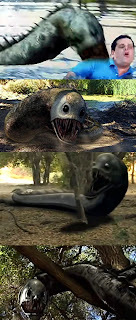 No escape from the razortooth – whether in the water, out of thewater, on dry land, or even up a tree, it's gonna get ya!
Please click composite picture to enlarge individual photos in it
for viewing
(© PatriciaHarrington/Gravedigger Films/Capital Art Entertainment (CAE)/PUSH/Lionsgate –reproduced here on a strictly non-commercial Fair Use basis foreducational/review purposes only)
No escape from the razortooth – whether in the water, out of thewater, on dry land, or even up a tree, it's gonna get ya!
Please click composite picture to enlarge individual photos in it
for viewing
(© PatriciaHarrington/Gravedigger Films/Capital Art Entertainment (CAE)/PUSH/Lionsgate –reproduced here on a strictly non-commercial Fair Use basis foreducational/review purposes only)
Several months after viewing Razortooth, I purchased and watched inquick succession another monster movie with genetically-engineered mega-fishesas its animal antagonists. This movie was the aptly-entitled Frankenfish, and here is the mini-reviewthat I wrote about it afterwards:
FRANKENFISH
 My official UK DVD of Frankenfish (© Mark A.Z. Dippé/ColumbiaTriStar/Syfy – reproduced here on a strictly non-commercial Fair Use basis foreducational/review purposes only)
My official UK DVD of Frankenfish (© Mark A.Z. Dippé/ColumbiaTriStar/Syfy – reproduced here on a strictly non-commercial Fair Use basis foreducational/review purposes only)On 16May 2024, I watched my recently-purchased DVD of the 20-year-old TV monstermovie Frankenfish.
Directedby Mark A.Z. Dippé, and released in 2004 by Columbia TriStar for the TV channelSyfy), Frankenfish is a very genericMM, and is all about some huge, voracious, genetically-modified Chinese (akanorthern) snakehead fishes Channa argusthat have been let loose into a Louisiana bayou where they wreak bloodthirstyhavoc upon its alligators and human inhabitants alike. (In real life conversely,this gourami-related species does not exceed 5 ft long at most, and is usuallyless than 4 ft.)
Consequently,the appropriately-named Sam Rivers (played by Tory Kittle), a medical examiner,is dispatched to the besieged bayou, together with biologist Mary Callaghan(China Chow), only to discover that they have as big a battle on their handswith the locals' firmly-ingrained superstitions and faith in black magicsolutions to the situation as they do with the monsters themselves – which loseno time in picking off the humans, one by one...
 A real Chinese (northern) snakehead(public domain)
A real Chinese (northern) snakehead(public domain)
Amusingly,whoever wrote the DVD's back-cover blurb presumably had no idea what asnakehead is and was therefore led badly astray by its name (and had apparentlynot even watched the movie itself, in which snakeheads are accuratelydescribed).
Forthe blurb writer described the movie's monsters as being not only "massive,genetically-engineered, flesh-eating fish" but also as having been"scientifically bred with a deadly snake"! Now that's a monster movieI'd definitely pay good money to watch!!
Asfor this one, the monster fishes when seen briefly out of the water are ok, butas the main storyline takes place almost entirely at night, I didn't see asmuch of them as I'd like to have done. But in compensation, there is a veryunexpected and entertainingly chilling closing scene to look out for, featuringthe ever-troublesome character Dan (Matthew Rauch).
If you'd like to watch an officialFrankenfish trailer, please click here to view one on YouTube.
Finally:to view a complete chronological listing of all of my Shuker In MovieLandblog's film reviews and articles (each one instantly accessible via a directclickable link), please click HERE, and please click HERE to view acomplete fully-clickable alphabetical listing of them.
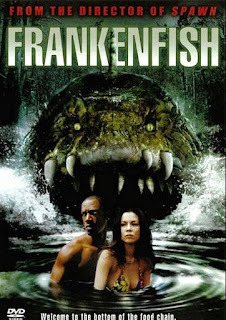 The official American DVDfor Frankenfish
(© Mark A.Z.Dippé/Columbia TriStar/Syfy – reproduced here on a strictly non-commercial FairUse basis for educational/review purposes only)
The official American DVDfor Frankenfish
(© Mark A.Z.Dippé/Columbia TriStar/Syfy – reproduced here on a strictly non-commercial FairUse basis for educational/review purposes only)
REVIEWING RAZORTOOTH, A DECIDEDLY FISHY MONSTER MOVIE - AND NOT FORGETTING FRANKENFISH TOO!
 My official Lionsgate Region 1 DVD of Razortooth (© Patricia Harrington/Gravedigger Films/Capital ArtEntertainment (CAE)/PUSH/Lionsgate – reproduced here on a strictlynon-commercial Fair Use basis for educational/review purposes only)
My official Lionsgate Region 1 DVD of Razortooth (© Patricia Harrington/Gravedigger Films/Capital ArtEntertainment (CAE)/PUSH/Lionsgate – reproduced here on a strictlynon-commercial Fair Use basis for educational/review purposes only)Genetically-modified beasts, i.e. creaturesconverted from the mundane into the monstrous by mad scientists of the kind belovedby film audiences and directors alike for over a century now, have long been astaple theme in science fiction movies, and the two examples reviewed andmini-reviewed respectively here, both of which are of the piscean persuasion,are definitely no exception to this trend. So as 2024 winds down on this, its final day,why not wind down too by leisurely perusing these cinematic offerings originallypenned by me for my sister blog Shuker In MovieLand? Unless of course you're anichthyophobe, whereupon the time to look away is right now!
My movie watch almost exactlya year ago, on 20 December 2023, was my long-owned but previously-unviewed LionsgateRegion 1 DVD of Razortooth, in orderto find out at long last just how very far short this horror/monster moviewould fall in comparison to what I'd always naturally assumed was the extremevisual hyperbole of its DVD's ultra-dramatic front cover illustration (whichopens this present ShukerNature blog article) – only to discover to my greatsurprise that, if anything, the actual movie was even more OTT than saidillustration!!
Directed by PatriciaHarrington, and released in 2007 by CAE/PUSH, Razortooth is on the surface just another of those numerousmodern-day CGI-laden creature features in which a group of diverse people arebrought together in a shared spine-chilling experience of a horrific monster onthe rampage. The latter usually constitutes either a freakishly large orgenetically-altered mutant individual of a known present-day species or somegargantuan prehistoric horror retrieved from the distant past either directlyvia time-travel or once again via genetic manipulation.
Said monster thensystematically slaughters in a variety of different (but usually gory) meansvirtually every human character in the movie, steadily devouring its way up thecast list from bit-part players to supporting characters and then, finally,confronting the leads in a grand do-or-die climactic battle before expiringwith just enough screen time left for the surviving leads to exchange somelight banter before the credits roll.
In Razortooth, the titular monster is a genetically-modified Asianswamp eel (much more about which later) of huge size and voracious appetitethat has escaped into the Florida Everglades from the laboratory thatengineered it, and now is diligently decimating everything and everyone that itencounters there – escaped convicts, Irish wolfhound, teenage canoeists, theyall suffer the same gruesome fate, albeit executed in an array of imaginativesplatter fests. Incidentally, I should warn you that this particular moviecontains far more blood and gore than is usual for a low-budget modern-daycreature feature of the Syfy-similar genre, which is why it holds an R ratingcertificate in the States, so beware.
Normally at this point I'dpresent my own précis of the plot, but in this case the latter is so generic,and also because there is one particular aspect of the movie, a zoologicalaspect, that I'd much prefer devoting the majority of this review to (especiallyas it does not appear to have been covered by anyone else whose reviews I'veread), I've elected to save time and space by simply quoting instead a very succinct,accurate summary of it penned by Brazilian viewer Claudio Carvalho that Iencountered on IMDb's Razortooth entry,so here it is:
Two prisonersescape through the swamp land in Everglades and the search party is attacked bya giant mutant eel and is considered missing. The Animal Control agent DelmarCoates is searching [for] a missing dog with his ex-wife Sheriff RuthGainey-Coates and he discovers the remains of the animal. Meanwhile members ofa canoe club organize an expedition through the swamp. When Sheriff Ruthorganizes a manhunt to capture the criminals, Delmar informs that his formerfriend, Dr. Soren Abramson, who is chasing the eel with a group of collegestudents, is the [person] responsible for [this] mutant species [sic –specimen]. Sheriff Ruth organizes two teams to hunt the prisoners and the eel.
The two lead characters areDelmar Coates (played by Doug Swander) and Sheriff Ruth Gainey-Coates (KathleenLaGue), so it will come as no surprise to learn that they are still standing,just about, by the time that we reach this movie's big, explosive finish – andI do mean big, and explosive!! What may indeed come as a surprise, conversely,is spotting a familiar face playing one of the lesser characters – yes indeed,Josh Gad (playing ill-fated Jay Wells), in one of his earliest big-screen rolesbefore going on to the likes of Pixelswith Adam Sandler, Disney's live-action Beautyand the Beast, and the voice of Olaf the snowman in Frozen, among many others.
 Eyeballing the razortooth: not a sight that you'd ever want tosee close-up – or from any distance, for that matter! Please click composite picture to enlarge individual photos in it
for viewing
(© PatriciaHarrington/Gravedigger Films/Capital Art Entertainment (CAE)/PUSH/Lionsgate –reproduced here on a strictly non-commercial Fair Use basis foreducational/review purposes only)
Eyeballing the razortooth: not a sight that you'd ever want tosee close-up – or from any distance, for that matter! Please click composite picture to enlarge individual photos in it
for viewing
(© PatriciaHarrington/Gravedigger Films/Capital Art Entertainment (CAE)/PUSH/Lionsgate –reproduced here on a strictly non-commercial Fair Use basis foreducational/review purposes only)
But now, let's move on to whatfor me was the all-important feature of this monster movie – the specificzoological nature of the razortooth!! (Curiously, despite someone in theproduction company having specifically devised this memorable moniker for it, Idon't actually recall 'razortooth' being employed anywhere within the film,other than as its title). As I mentioned earlier, this creature is supposed tobe a genetically-modified, super-sized mutant specimen of a genuine speciesknown zoologically as the Asian swamp eel Monopterusalbus.
Native to shallow, muddyfreshwater wetlands across eastern and southeastern Asia, this air-breathing eel-shapedspecies (but a synbranchid rather than a true eel), measuring only a verymodest 3 ft or less, has indeed been introduced into the USA – beginning duringthe 1990s in Georgia, from where they themselves migrated into the FloridaEverglades (their air-breathing ability enabling them to move overland inlimited fashion if the land in question is water-saturated, but not if dry).
Due to the deleterious effectthat its presence is having upon various native crayfish species, however, theAsian swamp eel is nowadays deemed an invasive species in these States, withattempts being made to control its burgeoning numbers and physically removespecimens where possible.
Needless to say, however it doesnot exist in any kind of mutant, extra-large version, and in any case thisspecies confines itself to a diet of aquatic worms and insects, frogs, fishes,terrapin eggs, and crustaceans – as opposed to gorging itself upon humans andwolfhounds! But these are not the only major differences between the real Asianswamp eel and its monstrous movie counterpart.
Although much was made duringthe film regarding the disturbing nature of its true-life invasive presence inFlorida's Everglades, in terms of its morphology the Asian swamp eel is nothingremotely frightening or dangerous, possessing only small, inconspicuous jawsand a totally smooth, featureless body. So how was this innocuous creaturegoing to play the central role of a bloodthirsty terror? By not only greatlyincreasing its size but also appending to it some decidedly horrificcharacteristics purloined from various real but visually hideous pisceanpredators, that's how?
As a zoologist, moreover, Icould readily recognize which predators had been utilized, and they were allfrom a specific taxonomic family of deepsea marine fishes – Stomiidae, thebarbelled dragonfishes.
Totally unrelated to swampeels, but once again only a few feet long at most (usually a lot less), thesedragonfishes exist in several visibly different types, and it looks as if certainspecific characteristics sampled from three of these types were deftly combinedwith the elongate body of the Asian swamp eel to yield the murderous razortoothof this movie, as I duly demonstrate below via the following series ofcomparative illustrations:
 From top to bottom: the Asian swamp eel Monopterus albus; the viperfish Chauliodussp.; the black dragonfish Idiacanthusatlanticus; Alcock's boatfish Stomiasnebulosus; and the composite result, the razortooth; please click picture to enlarge individual images for viewing purposes (top four pix publicdomain; razortooth composite pic © Dr Karl Shuker)
From top to bottom: the Asian swamp eel Monopterus albus; the viperfish Chauliodussp.; the black dragonfish Idiacanthusatlanticus; Alcock's boatfish Stomiasnebulosus; and the composite result, the razortooth; please click picture to enlarge individual images for viewing purposes (top four pix publicdomain; razortooth composite pic © Dr Karl Shuker)
As can readily be seen fromthis comparison: if the viperfish's head and jaws brimming with javelinesqueteeth, the black dragonfish's nearly membrane-less spiny dorsal fin (butextended along the eel's entire dorsal surface, not just the posterior half ofit as in the dragonfish), and the boatfish's unusual arrowhead-like dorsal andventral pre-terminal fins are added to the Asian swamp eel, the result is therazortooth. Apparently, Jeff Farley, the special effects expert who worked on Babylon 5, created the razortooth, so hehad evidently conducted some sound ichthyological research during this process.
Moreover, there is no doubtthat for much of the time, whether in the water or on land, or even when itslithers up into trees, the razortooth is impressive enough to keep theviewer's eyes glued to the screen, but most especially when it is very rapidly undulatinghorizontally in dramatic whiplash manner as it pursues its human prey on land,thus adopting the same mode of movement that snakes utilize.
The big problem comes fromthis monster's body size, which is anything but constant. One moment therazortooth is so huge that it rears vertically above the water like alatter-day plesiosaur from those now-dated prehistoric animal books from the1960s and 70s that habitually portrayed these aquatic reptiles as swan-necked.The next moment it is small enough and narrow enough to swim up through theexit pipe of a toilet or shower unit in order to seize hold of theunsuspecting, hapless human utilizing said facility. Then suddenly it's bigenough again to bite a man in half, or to be wrestled with by the redoubtableDelmar, and so on…
By way of mitigation for suchmorphological inconstancy, at one point scientist Dr Abramson (Simon Page) tellshis students about how flexible the muscular bodies of eels are, enabling themto squeeze through holes and crevices ostensibly too small for this to bepossible. That is true, but there are limits, even for a mutant eel ('mutant'being another oft-utilised get-out-of-jail card in monster movies forexplaining seemingly impossible feats performed by the monster in question!).
Anyway, such quibbles aside,and if you're not hoping for any in-depth characterization of the mega-eel'snumerous victims either, Razortoothis certainly an enjoyable creature feature (unless you're not onlyichthyophobic but also haemophobic!). And unlike many of its oh-so-seriouscontemporaries in this genre, it even purposefully includes a blacker shade ofblack vein of tongue-in-cheek humour running through it, but without descendingto spoof or parody levels. Monster movie purists may well hate this flick, ofcourse, but at least its choice of animal antagonist makes an interesting,diverting change from the more usual giant invertebrates, prehistoricsurvivors, and belligerent ape-men that tend to dominate this cinematiccategory.
Razortooth is currently available towatch free of charge on YouTube, so if you'd like to do so, just click here. Or click hereif you'd simply like to watch an official trailer for it.
 No escape from the razortooth – whether in the water, out of thewater, on dry land, or even up a tree, it's gonna get ya!
Please click composite picture to enlarge individual photos in it
for viewing
(© PatriciaHarrington/Gravedigger Films/Capital Art Entertainment (CAE)/PUSH/Lionsgate –reproduced here on a strictly non-commercial Fair Use basis foreducational/review purposes only)
No escape from the razortooth – whether in the water, out of thewater, on dry land, or even up a tree, it's gonna get ya!
Please click composite picture to enlarge individual photos in it
for viewing
(© PatriciaHarrington/Gravedigger Films/Capital Art Entertainment (CAE)/PUSH/Lionsgate –reproduced here on a strictly non-commercial Fair Use basis foreducational/review purposes only)
Several months after viewing Razortooth, I purchased and watched inquick succession another monster movie with genetically-engineered mega-fishesas its animal antagonists. This movie was the aptly-entitled Frankenfish, and here is the mini-reviewthat I wrote about it afterwards:
FRANKENFISH
 My official UK DVD of Frankenfish (© Mark A.Z. Dippé/ColumbiaTriStar/Syfy – reproduced here on a strictly non-commercial Fair Use basis foreducational/review purposes only)
My official UK DVD of Frankenfish (© Mark A.Z. Dippé/ColumbiaTriStar/Syfy – reproduced here on a strictly non-commercial Fair Use basis foreducational/review purposes only)On 16May 2024, I watched my recently-purchased DVD of the 20-year-old TV monstermovie Frankenfish.
Directedby Mark A.Z. Dippé, and released in 2004 by Columbia TriStar for the TV channelSyfy), Frankenfish is a very genericMM, and is all about some huge, voracious, genetically-modified Chinese (akanorthern) snakehead fishes Channa argusthat have been let loose into a Louisiana bayou where they wreak bloodthirstyhavoc upon its alligators and human inhabitants alike. (In real life conversely,this gourami-related species does not exceed 5 ft long at most, and is usuallyless than 4 ft.)
Consequently,the appropriately-named Sam Rivers (played by Tory Kittle), a medical examiner,is dispatched to the besieged bayou, together with biologist Mary Callaghan(China Chow), only to discover that they have as big a battle on their handswith the locals' firmly-ingrained superstitions and faith in black magicsolutions to the situation as they do with the monsters themselves – which loseno time in picking off the humans, one by one...
 A real Chinese (northern) snakehead(public domain)
A real Chinese (northern) snakehead(public domain)
Amusingly,whoever wrote the DVD's back-cover blurb presumably had no idea what asnakehead is and was therefore led badly astray by its name (and had apparentlynot even watched the movie itself, in which snakeheads are accuratelydescribed).
Forthe blurb writer described the movie's monsters as being not only "massive,genetically-engineered, flesh-eating fish" but also as having been"scientifically bred with a deadly snake"! Now that's a monster movieI'd definitely pay good money to watch!!
Asfor this one, the monster fishes when seen briefly out of the water are ok, butas the main storyline takes place almost entirely at night, I didn't see asmuch of them as I'd like to have done. But in compensation, there is a veryunexpected and entertainingly chilling closing scene to look out for, featuringthe ever-troublesome character Dan (Matthew Rauch).
If you'd like to watch an officialFrankenfish trailer, please click here to view one on YouTube.
Finally:to view a complete chronological listing of all of my Shuker In MovieLandblog's film reviews and articles (each one instantly accessible via a directclickable link), please click HERE, and please click HERE to view acomplete fully-clickable alphabetical listing of them.
 The official American DVDfor Frankenfish
(© Mark A.Z.Dippé/Columbia TriStar/Syfy – reproduced here on a strictly non-commercial FairUse basis for educational/review purposes only)
The official American DVDfor Frankenfish
(© Mark A.Z.Dippé/Columbia TriStar/Syfy – reproduced here on a strictly non-commercial FairUse basis for educational/review purposes only)
December 28, 2024
MONTEZUMA'S MYSTIFYING WOLF-PUMA – LESSER-KNOWN MEXICAN MYSTERY CATS, PART 3 (OF 3)
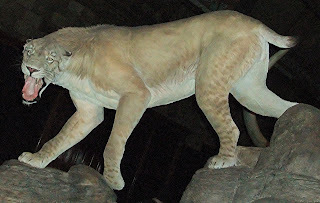 Life-sized reconstruction of the North Americanscimitar cat Homotherium serum (© DrKarl Shuker)
Life-sized reconstruction of the North Americanscimitar cat Homotherium serum (© DrKarl Shuker)So far, in Parts 1 and 2 (click hereand hereto read them) of my comprehensive 3-part article on lesser-known Mexicanmystery cats, I have documented no fewer than six different examples,incorporating a great deal of valuable information supplied to me on Facebookby Mexican palaeo-artist and cryptozoological enthusiast Hodari Nundu, who isalso a longstanding friend of mine on FB. In addition, he has very kindlypermitted me to include in my article a number of his exquisite illustrations –thanks Hodari!
And now, here is its third and final part, whichdeals with one final, seventh feline cryptid from Mexico, but which mayconceivably be the most mysterious one of all.
THE CUITLAMIZTLI – MONTEZUMA'S WOLF-PUMA
You may have noticed previously in this lengthy articlethat I have sometimes employed the less specific term 'feline cryptids' (ratherthan consistently utilising 'mystery cats') when referring to its subjects –and here's why. The subject under consideration here now was apparently feline(i.e. cat-like) in superficial appearance but may not have actually been a bonafide felid (i.e. a cat).
The creature in question is the cuitlamiztli, the mystifyingso-called wolf-puma or wolf-cat that was exhibited in the private zoo, theTotocalli, of the Aztec emperor Montezuma (=Moctezuma) II (c.1471-1520) and wasseen there by one of the Spanish conquistadors – before their leader HernánCortés ruthlessly authorized its total destruction in 1521, along with manyother significant buildings and edifices in the Aztec Empire's capital city,Tenochtitlan. But what exactly was it – a wolf, a puma, or something elseentirely? Read on, and decide for yourself.
Here is what I wrote about this enigmatic beast inmy book Mystery Cats of the WorldRevisited:
What may be the earliest known reference to this felid [the onza](although the term 'onza' was not actually used here) was made by Bernal Díazdel Castillo (c.1496-1584) – under the command of the infamous conquistadorHernán Cortés. In a report some time after having visited the famous zoo of theAztec king Montezuma, Castillo recorded seeing "tigers [jaguars] and lions[pumas] of two kinds, one of which resembled the wolf". In view of thewolf's long limbs and the corresponding characteristic of the onza, it istraditionally assumed that Castillo's 'wolf-cat' (known to the Aztecs as thecuitlamiztli) was indeed the onza...
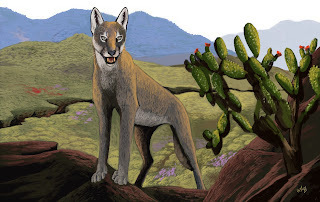 Artistic representation of Montezuma's wolf-pumaas a bona fide felid (© Hodari Nundu
Artistic representation of Montezuma's wolf-pumaas a bona fide felid (© Hodari Nundu
[However,] one further tantalising matter to consider regarding theonza is whether it really is the samecreature as the 'wolf-cat' spied by Castillo in Montezuma's zoo. For althoughone would naturally assume this to be the case, it is by no means conclusivelyestablished. After all, despite its long limbs the onza does not reallyresemble a wolf to any degree. Is it conceivable, therefore, that the Aztec 'wolf-cat'was actually some other, still unknown beast? I would be inclined to dismissthis idea totally – were it not for a certain tantalising fossil species.
Although more closely related to cats, hyaenas are quite dog-likein outward appearance. Moreover, whereas typically looked upon as Old Worldspecies, some hyaenas did exist at one time in the Americas too, which leads usinto the most fascinating aspect of this subject.
In several different Mexican localities, skeletons have been foundof a truly remarkable hyaena, which lived during the Pleistocene, i.e. acontemporary of M. trumani [thenow-extinct Truman's cheetah – see Part 2 of this article]. However, thisspecies, the hunting hyaena Chasmaporthetesossifragus, shared much more than a geological time period and ageographical locality with the latter American felid.
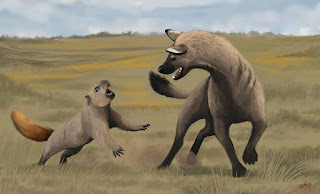 Artistic representation of a giant ground squirrel Paenemarmota confronting the huntinghyaena Chasmaporthetes in PlioceneMexico (© Hodari Nundu)
Artistic representation of a giant ground squirrel Paenemarmota confronting the huntinghyaena Chasmaporthetes in PlioceneMexico (© Hodari Nundu)
For C. ossifragus was acursorial dog-like hyaena – possessing notably long, slender limbs, and a verygracile body. In short, its appearance in life would have been the very epitomeof the descriptive term 'wolf-cat'. Is it possible that C. ossifragus did not die out during the Pleistocene, but instead persistedat least to the time of the Aztecs in the more remote Mexican mountain lands?No reports of such a creature are known today, hence even if it had survived to such a recent date, itis surely extinct now.
I feel that it is less likely for Mexico's mountains to possess twomystery gracile carnivores than one in modern times, especially when they mayhave competed with one another to some extent, having adapted to occupy similarecological niches. Nevertheless, it is certainly a thought-provoking coincidencethat a creature fitting Castillo's description even more closely than the onzashould have existed within this very same country at least as late as thePleistocene.
In hisFacebook message to me of 13 January 2024 regarding the tiricuate (see Part 2again), Hodari also suggested a new and, in view of a recent, very remarkablediscovery in Siberia (see below), very pertinent putative identity forMontezuma's wolf-puma. Namely, the scimitar cat Homotherium, belonging to the taxonomic family of machairodontidsor sabre-toothed cats, all of which are officially long-extinct.
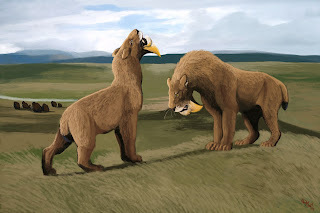 Two Homotheriumscimitar cats (© Hodari Nundu)
Two Homotheriumscimitar cats (© Hodari Nundu)
Hereis his suggestion:
You mention Chasmaporthetes [in my mystery catsbooks] as a possible identity for the wolf-puma in Montezuma's zoo – have youconsidered though the possibility of it being Homotherium itself? As far we know Chasmaporthetes died out around one million, 700,000 years ago. Homotherium was likely still around [inMexico, represented there by the North American species H. serum] in the late Pleistocene.
There's nodescribed remains from Mexico from this time, but the mummy* shows they were present in the latePleistocene in Eurasia where they were thought to die out earlier than in theAmericas so it wouldn't be a stretch to think some of them may have survivedlate in Mexico.
[* =the recently-described mummified anterior half of a three-week-old Homotherium latidens cub discovered in 2020 after its frozencarcase had emerged from Siberian Upper Pleistocene permafrost – click here to read the official scientific paper documentingthis unique, spectacular find, which was approximately 35,500 years old, makingit the youngest-known Asian specimen of Homotherium, and see photo below]
The last Homotherium species were ratherwolfish-bodied, endurance runners, long legs, relatively small paws withsemi-retractable claws – already pretty wolf-like in that regard. Their jawswould be longer. Their front incisors are protruding. Those are potentiallywolf-like features too.
Of course Homotherium was much bigger than a wolfor a puma as far we know but we would be talking about the southernmostpopulation of Homotherium in NorthAmerica, meaning maybe Bergmann's rule would apply [i.e. within a broadlydistributed taxonomic clade, populations and species of larger size are found in colder regions,whereas populations and species of smaller size are found in warmer regions].
Cat food forthought!
Absolutely!
Hodari's insightful commentsprovide a fascinating new line of well-reasoned speculation to ponder overconcerning the nature of Montezuma's mystery specimen. The mummified Homotherium cub's discovery wasextremely dramatic – the first time that physical remains (other thanfossilised bones) of a semi-complete machairodontid had ever been procured – sohow truly incredible it would be if researchers one day revealed that a livingmachairodontid species had persisted until as recently as the 1500s in Mexico,or anywhere else for that matter!
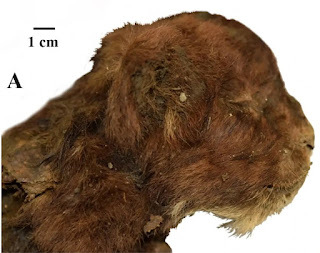 The head of the three-week-old Homotherium latidens scimitar cat discovered in frozen, mummified condition in Siberia and formally documented in 2024 (© A.V. Lopatin et al., 2024/Wikipedia –CC BY 4.0 licence)
The head of the three-week-old Homotherium latidens scimitar cat discovered in frozen, mummified condition in Siberia and formally documented in 2024 (© A.V. Lopatin et al., 2024/Wikipedia –CC BY 4.0 licence)
In summary re my 3-partarticle: I have to ask whether it is credible that even a country as large andecologically diverse as Mexico could at one time or another have been home tono fewer than eight feline cryptids (including the onza). Might it be moreprudent to assume that certain of these mystery cats (or cat-like entities) aresynonymous with certain others? Having said that, none of them appears to bebased merely upon distorted descriptions of any present-day species known toexist here. Perhaps, therefore, if indeed real, some of them are actuallyalready known to science but as various officially extinct, prehistoric specieswhose erstwhile existence in Mexico is confirmed by fossil evidence, yet whichmay have lingered elusively into the present.
As ever in cryptozoology,without physical contemporary evidence of them that can be formally examined, thereis no means of verifying the reality of any of the mystery beasts reported here(if only Sanderson's ruffed cat skins had survived – see Part 1). Nevertheless,documenting these reports of them is the next best procedure, to ensure thatsuch details are readily available for perusal by other researchers and aretherefore never lost – even though, sadly, at least some of these creaturesthemselves may well be.
Onceagain, I wish to thank Hodari most sincerely for his kindness in permitting meto include his illustrations here and for sharing such fascinating crypto-felidinformation with me.
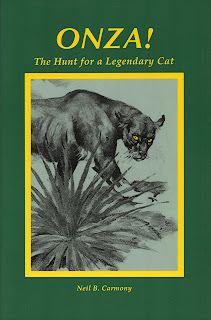 Noarticle on Mexican mystery cats, lesser-known or otherwise, would be completewithout at least one onza-related illustration, so here is the front cover ofthe definitive book on this crypto-cat (© Neil B Carmony/High-Lonesome Books –reproduced here on a strictly non-commercial Fair Use basis foreducational/review purposes only)
Noarticle on Mexican mystery cats, lesser-known or otherwise, would be completewithout at least one onza-related illustration, so here is the front cover ofthe definitive book on this crypto-cat (© Neil B Carmony/High-Lonesome Books –reproduced here on a strictly non-commercial Fair Use basis foreducational/review purposes only)
December 27, 2024
DEADLY DEER-PUMAS, LITTLE LIONS, GIANT JAGUARUNDIS, AND MORE! – LESSER-KNOWN MEXICAN MYSTERY CATS, PART 2 (OF 3)
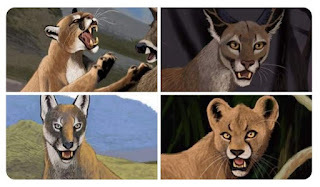 One long-recognized and three currently-unrecognizedMexican felids – (top left) the puma; (top right) the mazamiztli; (bottom left)Montezuma's wolf-puma; (bottom right) the tlalmiztli (© Hodari Nundu)
One long-recognized and three currently-unrecognizedMexican felids – (top left) the puma; (top right) the mazamiztli; (bottom left)Montezuma's wolf-puma; (bottom right) the tlalmiztli (© Hodari Nundu) InPart 1 of my ShukerNature blog article on lesser-known Mexican mystery cats (pleaseclick hereto read it, and also click here to read my earlier ShukerNature articledocumenting Mexico's best-known mystery cat, the onza), I documented themystifying ruffed cat, some skins of which were actually procured by Americanzoologist and cryptozoologist Ivan T. Sanderson while visiting Mexico, only forthem to be destroyed when the building in which they had been deposited by himfor safe-keeping was flooded – isn't that always the way with cryptozoologicalspecimens?!
Now,here in Part 2 I am casting my metaphorical nets much wider, to take in nofewer than five additional feline cryptids from this self-same North American country,most of which were brought to my attention by Mexican palaeo-artist andcryptozoological enthusiast Hodari Nundu on Facebook, where we have beenfriends for many years. In addition, Hodari has very kindly permitted me toinclude in this present article a number of his wonderful illustrations – thanks Hodari!
So, withoutfurther ado, let's commence our survey of these five additional feline cryptidsof Mexico, beginning with the mazamiztli or deer-cat.
THE MAZAMIZTLI
On 22 and 23 January 2024, Hodari posted onhis Facebook page some fascinating details regarding a third Mexican mysterycat, seemingly distinct from both the onza and the ruffed cat.
Hodari noted that in his 1570s magnum opus Historia Natural de la Nueva España,dealing with the wildlife of what is nowadays Mexico, Spanish naturalistFrancisco Hernández de Toledo wrote about an intriguing, unidentified beastreferred to locally as the mazamiztli. This name is a combination of twoothers, both of Nahuatl (imperial Aztec) origin – maza ('deer') and miztli('puma'). Hernández stated that it was called by this compound name due to itscombining various deer traits and puma traits, but unfortunately he did notelaborate further.
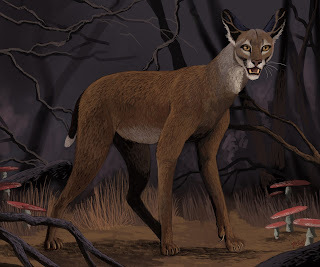 Hodari's exquisite artistic rendition of the mazamiztlibased upon descriptions of it in historical documents (© Hodari Nundu)
Hodari's exquisite artistic rendition of the mazamiztlibased upon descriptions of it in historical documents (© Hodari Nundu)
However, a second author, the 16th-CenturyFranciscan missionary priest and Aztec scholar Friar Bernardino de Sahagún, didprovide additional details. He stated that the mazamiztli is the size andcolour of deer, and also possesses paws and (in males) antlers like deer, butit sports the very sharp claws and fangs of a puma, and it does not eat grasslike deer. Instead, it walks among deer and when hungry it seizes one of theseunsuspecting creatures, disembowels it with its claws, and eats its entrails.Apparently, the mazamiztli looks so similar to real deer that it can only bedistinguished by them via its foul smell (so presumably it hunts downwind ofthem to conceal its scent?).
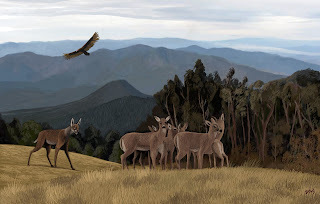 A mazamiztli seeking to stealthily infiltrate aherd of deer before selecting one of them as its next prey victim (© Hodari Nundu)
A mazamiztli seeking to stealthily infiltrate aherd of deer before selecting one of them as its next prey victim (© Hodari Nundu)
Recalling that the onza is itself supposedly gracilelike deer, might this cat and the mazamiztli simply be one and the same?However, the onza has its own, separate Nahuatl name, cuitlamiztli('wolf-puma') – but see also Part 3 of my article for further, potentially conflicting details regarding this name.
Having said that, the mazamiztli seems irresistiblylike a feline version of the South American maned wolf Chrysocyon brachyurus, whose very elongate limbs and extra-largeears make it look remarkably deer-like in superficial appearance.
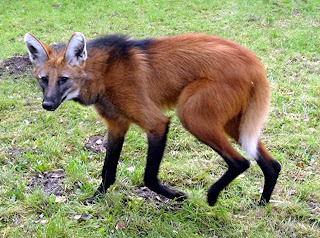 The surprisingly deer-like maned wolf (© Markus Bühler)
The surprisingly deer-like maned wolf (© Markus Bühler)
Consequently, I have wondered if what we are dealingwith here is a sexually dimorphic feline species, i.e. with the onza akacuitlamiztli conceivably being one sex of this species and the mazamiztli beingthe other, visibly different sex. Certainly, males are often noticeably largeror burlier than females in a number of different cat species. However, FrBernardino's inclusion of antlers as a male mazamiztli characteristic arguesagainst this creature being real rather than folkloric.
It would be very interesting if more informationregarding this Mexican mystery beast is unearthed in the future, and it is veryencouraging to know that serious researchers such as Hodari are activelyperusing historical manuscripts that have not previously attracted specificcryptozoological attention. Who knows what other discoveries may be made inthis way?
THE LEONCILLO
And as if three Mexican mystery cats were not extraordinaryenough, I also received in January 2024 some information concerning a potentialfourth one!
It took the form of a short account posted on 8January beneath my ShukerNature blog article on the onza (click here) by a reader based inMexico. The reader did not reveal their name, but affirmed their longfascination regarding the onza and then provided some thought-provokinginformation concerning not only this cat but also a smaller, separate felineform that they termed the leoncillo.
The older members of the reader's Jalisco-inhabitingfamily have spoken about this animal, which they liken to a diminutive lionwith a small mane. The reader showed their uncle a picture of an Asiatic lion,which famously has a much smaller, sparser mane than African lions and issmaller in stature too, and the uncle replied that this is exactly what theleoncillo looks like. Moreover, even its name translates as 'little lion'.
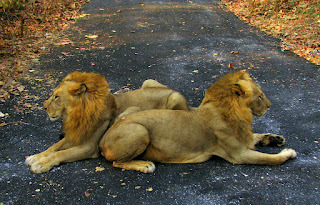 Two male Asiatic lions i
n Sanjay Gandhi National Park, Borivali, Mumbai Lion Safari (©supersujit/Wikipedia –
CC BY-SA 2.0 licence
)
Two male Asiatic lions i
n Sanjay Gandhi National Park, Borivali, Mumbai Lion Safari (©supersujit/Wikipedia –
CC BY-SA 2.0 licence
)
Could this creature be one and the same as theruffed cat? I gave the latter crypto-cat that name in the apparent absence ofany known local name for it, but perhaps its local name is leoncillo.Alternatively, might the leoncillo genuinely be a fourth Mexican mystery cat inits own right?
Yet although Mexico is a very large country, withplenty of remote mountainous areas, could it truly harbour no fewer than aquartet of mystery cats? Without any physical evidence to examine for at leastthree of them (or maybe all four if, as I suggested a while back, the allegedRodriguez onza specimen wasn't a true onza after all, but merely a puma thatlooked like one), at this point we simply can't say. In any case, as will now be revealed, the Mexican mystery cat count doesn't even stop at four...
THE TLALMIZTLI
In his afore-mentioned 1570s magnum opus Historia Natural de la Nueva España,dealing with the wildlife of what is today Mexico, Spanish naturalist FranciscoHernández de Toledo has been revealed by Hodari to have written about not onebut two Mexican mystery cats. One is the mazamiztli, but the other is verydifferent, the tlalmiztli.
Providing details on his Facebook page on 26 January2024, Hodari notes that this unidentified felid was said by Hernández to be smallerthan a domestic cat but with a face like a lion, and despite its small size wasvery ferocious. Hernández also stated that a specimen of what he felt likely tohave been this same mysterious species had been sent from Isla Margarita (inmodern-day Venezuela) to the King of Spain but, tragically, it had died duringthe long sea voyage to Spain. Once again, it resembled a very small lion.
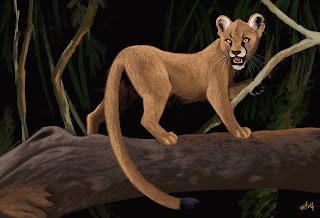 Artistic representation of the tlalmiztli's likely appearance inlife (© Hodari Nundu)
Artistic representation of the tlalmiztli's likely appearance inlife (© Hodari Nundu)
Hodari speculated that it may have possibly been thejaguarundi Herpailurus yagouaroundi,a lithe, slender, low-slung, and very long-tailed wild cat slightly larger than a domestic cat, which isnative to much of South America (including Venezuela) and Central America, withits range stretching up as far north as northern Mexico in North America, withoccasional specimens documented in the USA. To my mind, however, it looks ifanything more like a miniature lioness than a lion as far as potential leoninecomparisons are concerned. Another possible identity candidate suggested for it by Hodari is a kinkajou Potos flavus, that small golden-furredLatin American procyonid related to raccoons and coatis.
 Vintage colour engraving from 1849 of a kinkajou (public domain)
Vintage colour engraving from 1849 of a kinkajou (public domain)
I am reminded of the leoncillo, the maned lion-likeMexican mystery cat that I've documented earlier here, but this was not saidto have been smaller than a domestic cat. So, just like the latter animal andalso the mazamiztli, the tlalmiztli currently remains an anomaly.
Incidentally, worth noting here is that thejaguarundi is most closely related to the puma (aka cougar and mountain lion) Puma concolor. Indeed, some authoritiesactually classify it as Puma yagouaroundi,and these two species collectively form a sisterclade to the Old World cheetah Acinonyxjubatus, a species that as recently as the Pleistocene possessed gracilepuma-like New World relatives, housed in the genus Miracinonyx. In fact, a surviving Miracinonyx cheetah, specifically Truman's cheetah M. trumani (which officially becameextinct 12,000 years ago), is one identity that has been proposed in the pastfor the onza.
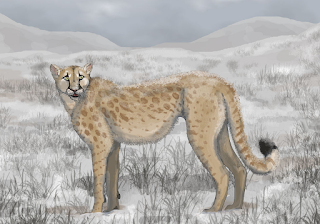 Artistic representation of the possible appearance in life of Truman'scheetah (© Sheatherius/Wikipedia –
CC BY-SA 4.0 licence
)
Artistic representation of the possible appearance in life of Truman'scheetah (© Sheatherius/Wikipedia –
CC BY-SA 4.0 licence
)
THE TIRICUATE
On 13 December 2024, I received from Hodari viaFacebook a message containing some information regarding yet another Mexicanmystery cat. This one is called the tiricuate. It is said to inhabit the areaaround Lake Chapala, Mexico's largest lake, in the state of Jalisco, and Hodarispeculates that this cat may derive its name from 'tilcuate', a name oftenapplied by the locals to a snake. It is described as a black arboreal catsporting a very long tail, and it attacks people, hence it is quite feared.
Hodari once saw a taxiderm specimen of a catresembling a giant jaguarundi (see below). Consequently, he wonders if thatspecimen and the tiricuate may be related.
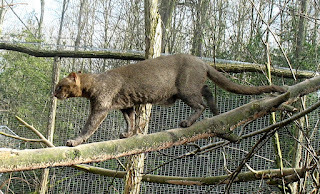 Grey/black phase of the jaguarundi (© Cédric Gravelle/Wikipedia–
CC BY 2.5 licence
)
Grey/black phase of the jaguarundi (© Cédric Gravelle/Wikipedia–
CC BY 2.5 licence
)
As is well known, the jaguarundi exists in two discrete colourphases, both of which can occur within a single litter. One of these phases isbright red to dull brown and is known as the eyra (it was once mistakenlythought to be a separate species in its own right), the other is ash-grey toblack in colour. This latter version certainly resembles the tiricuate basedupon Hodari's description, and jaguarundis are indeed arboreal.
So whereas a normal-sized jaguarundi is too small topose a threat to humans, perhaps an extra-large variety does also exist – onethat is big enough, and savage enough, to be capable of attacking people?
A GIANT TAXIDERM JAGUARUNDI?
Following my request to Hodari for details concerning theintriguing taxiderm specimen of a cat resembling a giant jaguarundi that he hadonce seen in Mexico, I received the following in-depth account of it from him viaFacebook on Christmas Day 2024:
Let's see. Thishappened in the early 2000s – most likely between 2000 and 2003. Sadly I didn'thave a camera and of course smartphones weren't a thing yet so I am relying onmy memory for this, but my memory is quite good for creature relatedexperiences. The place was a town in Jalisco (my home state) called Mazamitla(from Nahuatl, "place where deer are hunted with arrows" – you mightrecognize the word mazatl, deer, because of the mazamiztli).
Anyway this isa town about 124 km south of Guadalajara. People from the city often visit iton weekends or holidays to rest and enjoy nature: it is located in amountainous region which is largely covered on pine forests. I went there withmy family on vacation. It is not uncommon for hotels or restaurants in Jaliscoto have taxidermied animals but usually it is deer's heads or various birds soI was taken by this cat I saw on a restaurant, the name of which unfortunatelyI can't remember. It was one of those countryside restaurants so common inJalisco (I imagine in much of Mexico) that sell sheep and goat meat dishes thatyou'd be hard pressed to find in the city.
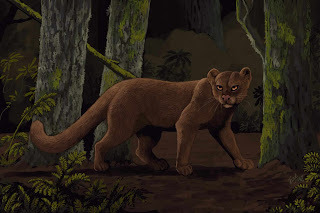 Hodari's reconstruction of how in life the giantjaguarundi-like cat that he observed as a taxiderm specimen in a restaurant atMazamitla during the early 2000s may have looked (© Hodari Nundu)
Hodari's reconstruction of how in life the giantjaguarundi-like cat that he observed as a taxiderm specimen in a restaurant atMazamitla during the early 2000s may have looked (© Hodari Nundu)
The cat wasmounted at a certain height so that it looked like it was perched near theceiling waiting to pounce. The mount was quite good and naturalistic. Iimmediately identified it as a jaguarundi based on the following traits:
- Plain browncoat, richer and darker than a puma's.
- Lack of thepuma's distinctive black and white muzzle markings.
- shortrounded ears.
- shorter,wider face overall.
- shorterlimbs compared to the body than in a puma.
- long,rectangular shaped torso without the characteristic higher rump of the puma(due to long jumping legs).
- Fur had asort of grizzled or agouti-patterned appearance so that even though the animal'scolor was plain, the individual hairs must have been tipped or streaked withlight and dark bands. This is very common in jaguarundi but not so much inpuma.
Having workedas a zookeeper in a park that kept jaguarundi, I was very familiar with them,and my brain wanted to identify this as a jaguarundi because it definitelyleaned more towards it than towards puma, but the problem was the size. Evenassuming the skin could be somewhat stretched (which wasn't evident to me atthe time as the mount looked natural with no obvious distortions), it stillwould have been a c. 30 kg cat in life which is far superior to the size of anyjaguarundi (but comparable in size to the prehistoric Puma pumoides, which is believed to have been closer to jaguarundithan to puma [and is known from fossil remains uncovered in Argentina]).
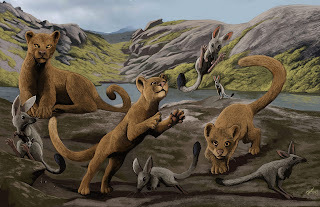 Puma pumoides hunting Argyrolagus, a polydolopimorphidmarsupial (© Hodari Nundu)
Puma pumoides hunting Argyrolagus, a polydolopimorphidmarsupial (© Hodari Nundu)Unfortunatelylike I said I had no camera or smartphone back then, nor was I able to find outmore about the specimen. I would assume that it was hunted somewhere in thevicinity since the mounted animals you see in these sorts of place usually are.Also there's a rich tradition of mystery cat sightings in Jalisco, most ofwhich are thrown under the catch all moniker of onza. Many Jaliscan biologistsand photographers will tell you that the onza is the jaguarundi, but thisdoesn't explain the wild disparity in size between the regular jaguarundi andthe cats reported to be large enough to attack people, and described as inbetween the jaguarundi and puma in size, or even puma-sized but with differentproportions. I have collected a few sighting reports from people in my regionand most of them are adamant that the onza is not the puma, and that it is toobig to be jaguarundi.
My hypothesisis that there's a third form of acinonychine cat [i.e. in addition to the pumaand the jaguarundi] in Jalisco (and possibly elsewhere since Mazamitla is closeto the border with neighboring state Michoacán) that is more closely related tothe jaguarundi (or at least LOOKS to be), and is sized between the jaguarundiand puma. It is consistently reported from mountain areas which means:
- it might bea form of jaguarundi evolving larger size as a response to the decline oflarger predators like puma and jaguar.
- it might bea form of jaguarundi that evolved larger size as a response to colder climatein higher altitudes.
- it might bea relic of the Pleistocene, a larger acinonychine that hasn't been properlyidentified yet and which (as is known from other Mexican endémics) may havebeen more widespread during glacial periods but is now isolated in cold regionsin mountain ranges.
As such itmight be a new species, subspecies, or even a giant jaguarundi populationstretching the size range of the species beyond what we thought possible. Afterall, the jaguarundi still is poorly known.
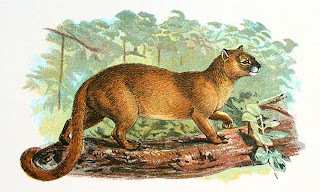 Vintage 19th-Century illustration of the eyra,the jaguarundi's red/brown colour phase (public domain)
Vintage 19th-Century illustration of the eyra,the jaguarundi's red/brown colour phase (public domain)
Any of the above options regarding the identity of extra-large jaguarundis would be exciting. So too would the rediscovery of the taxiderm specimenseen by Hodari in that Mazamitla restaurant, but whether after two decades itis still there can only be determined if the restaurant in question can beidentified, visited (if still in existence), and, if this specimen is indeed still there, photographedand asked questions about its origin and history. If a sample of its fur couldalso be procured (but only with the owner's permission, naturally), that would beof great value scientifically, as a basis for conducting comparative trichologicalstudies. Consequently, if (so many 'ifs'!) anyone reading this blog article of mine is thinking ofvisiting Mazamitla, be sure to look out for a restaurant there containing sucha specimen!
Incidentally, as Hodaridescribes its pelage colour as brown, it would appear to have been a specimenof the jaguarundi's eyra (red/brown) colour phase – always assuming, of course,that it were indeed a normal (albeit extra-large) jaguarundi. For in addition tohis above-quoted description, Hodari has also mentioned to me that its head wasbigger and its tail shorter than those of a normal jaguarundi, and that he hassought to depict these distinguishing features in his illustration of it.
In the time-honouredtradition of saving the best – or at least the most mysterious – to the last,be sure to check out the third, final part of this article when I post it onShukerNature later this week, because its subject is so strange that althoughapparently feline in superficial appearance it may prove to be something verydifferent indeed taxonomically from any bona fide felid. I'm referring of course toMontezuma's wolf-puma, so don't miss it!
 Portrait of Montezuma (=Moctezuma) II,
attributed to Antonio Rodriguez (1636-1691) (publicdomain)
Portrait of Montezuma (=Moctezuma) II,
attributed to Antonio Rodriguez (1636-1691) (publicdomain)
December 26, 2024
RUFFED CAT REVELATIONS - LESSER-KNOWN MEXICAN MYSTERY CATS, PART 1 (OF 3)
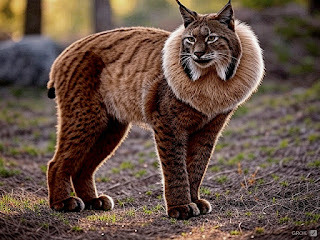 Reconstructionof the possible appearance in life of Mexico's mysterious ruffed cat (createdby me using Grok)
Reconstructionof the possible appearance in life of Mexico's mysterious ruffed cat (createdby me using Grok)When cryptozoologists think of Mexicanmystery cats, the example that always comes instantly to mind is the onza –that elusive gracile enigma that may simply be a bona fide puma, taxonomically speaking, or may not be at all, becausethe controversy regarding its taxonomic status is still far from resolved(click here to read my detailed ShukerNaturearticle on this subject, and check out my definitive book on feline cryptids, Mystery Cats of the World Revisited,for additional information).
However, it is by no means the onlyMexican feline cryptid – I was aware of three others, but earlier this yearMexican palaeo-artist and cryptozoological enthusiast Hodari Nundu, who is alsoa longstanding friend of mine on Facebook, presented on his FB page someinformation regarding several additional ones. Not only that, he also prepareda series of exquisite full-colour illustrations of some of these creatures, andhas now very kindly permitted me to include them in my exclusive coverage hereon ShukerNature of his home country's fascinating diversity of lesser-known felinecryptids – thanks very much Hodari!
Having spent a very productive ChristmasDay morning yesterday writing this article (living alone with no family anymore, I enjoy Christmas in my own way, by doing what gives me pleasure andkeeps my mind occupied, which is writing), its final sizeable word countpersuaded me that it would be better served split into three separate,reader-friendly parts rather than presented as a single decidedly lengthy read.So that's what I've done. Herewith, therefore, is Part 1 (with Parts 2 and 3 followinglater this week), which I have devoted entirely to what may sound somewhatparadoxical – the best-known of these lesser-known Mexican mystery cats.Namely, the ruffed cat.
THERUFFED CAT
I first documented this hitherto obscure Mexicanmystery cat in my very first book, MysteryCats of the World (1989), but expanded my coverage ofit three decades later in that book's updated, greatly-enlarged second edition,the afore-mentioned Mystery Cats of the World Revisited.Here is what I wrote about it there:
The onza may still share Mexico with one other mystery felid. Tomy knowledge, however, this second crypto-cat's existence is based solely upona single account, written by the American zoologist, veteran cryptozoologist,and popular writer Ivan T. Sanderson in the form of an article published inApril 1973 by Pursuit - the officialperiodical of the Society for the Investigation of The Unexplained (SITU),which Sanderson founded. In his article, no name was allocated to the creature,but for reasons that will soon become evident, I shall refer to it here as theruffed cat.
During 1940, travelling alone through Mexico on a mammalogicalcollecting trip, Sanderson arrived at an unnamed mountain settlement in thestate of Nayarit's Sierra mountains. These are totally separated from theneighbouring Sierra Madre Occidentale ranges, and possess their own distinctiveflora and fauna. At this settlement, a few locals spoke Spanish, and Sandersonlet it be known that he was seeking specimens of a particular form of squirrel.The locals promised to obtain some for him, and in the meantime they broughtalong a number of skins of other mammals, in the hope of selling these to himtoo.
Amongst them was a large and very tough skin of a most unusualcat. The skin measured just over 6 ft from nose-tip to tail-base, with afurther l.5 ft constituting its relatively short tail. Of course, it isdifficult to say how closely these measurements reflected this cat's actuallength when alive, because it would be virtually impossible to ascertain howmuch the skin had stretched or shrunk during drying. Intriguingly (in view ofthe onza), Sanderson noted: "The legs appeared to have been rather longcompared to, say, a house-cat or a puma". The paws were still attached tothe skin and were very large, well-furred, and splayed, with most of them stillpossessing their claws, which were bright yellow in colour and very clearlyretractile. The cat's face was short (again like the onza).
The cat's pelage was firm dorsally, soft ventrally, andpredominantly brown in colour. The head and shoulders lacked markings, but theflanks and upper limbs bore a series of wavy stripes in alternate light anddark shades of brown, whereas the lower limbs were very dark brown in colour,almost approaching black. The ridge of the spine running along its back wasalso dark brown, and (as far as Sanderson could recall) so too was the tail.
By far the most outstanding feature of the skin, however, wasthat the hairs sited just behind its shoulders appeared to grow forward toyield a large ruff encircling the neck and covering the ears from above andbehind.
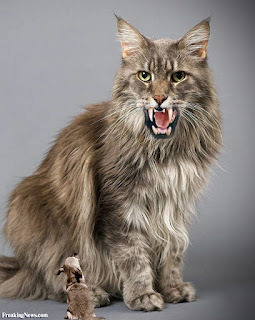 Artistic representation of the ruffed cat (© ownerof this illustration is unknown to me despite searching online, but I found theillustration itself
here
on the Cryptid Wiki website,where it is attributed to FreakingNews.com – reproduced here on a strictlynon-commercial Fair Use basis only for educational/review purposes only)
Artistic representation of the ruffed cat (© ownerof this illustration is unknown to me despite searching online, but I found theillustration itself
here
on the Cryptid Wiki website,where it is attributed to FreakingNews.com – reproduced here on a strictlynon-commercial Fair Use basis only for educational/review purposes only)
Sanderson stated that he bought this skin, and another smallerpelt of this same strange cat form that was in poorer condition but withsharper stripes. Together with other mammal skins that he bought, these felidpelts (which apparently cost a lot more than any of the others) were sewn up inseveral layers of sacking, and were finally stored in the government jail ofBelize, which Sanderson was using as a base.
Tragically, however, during a subsequent trip the jail waslashed by a severe hurricane and, being at sea-level, was completely floodedout. As a result, everything not in bottles was totally ruined, including theskins.
This is a most compelling, but, sadly, rather intangible affair,because there is so little in the way of hard facts that can be followed up.The area itself is unnamed; the skins are lost; and Ivan Sanderson, whotravelled there alone and hence was the only named eyewitness to them, can nolonger be questioned, as he passed away in 1973. The only hope is the possibleexistence still of the jail - perhaps, if it does survive, records regardingthe skins may too, which could add some details to the account left behind bySanderson.
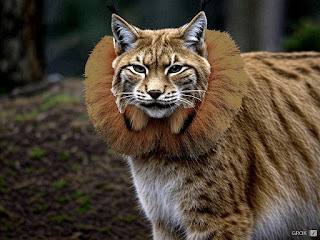 A third ruffed cat representation (created by meusing Grok)
A third ruffed cat representation (created by meusing Grok)
What could these mystery cats have been? Lynxes have relativelylong legs and short tail, large paws, and thick fur around the neck, which canlook a little like a ruff, but no lynx possesses anything remotely as extensiveas the ruff described by Sanderson for the Mexican ruffed cat. Moreover, as atrained zoologist and a mammal collector, Sanderson would surely have comparedits skins specifically with lynxes if they had appeared comparable with such.Instead, the detailed description that he gave does not fit that of any knownfelid.
The only sequel that I know of to this sorry saga is thatSanderson claimed that he later saw another skin of this very distinctive catform on sale at a tourist store in the big market at Colima, situated at thesouth end of Nayarit's mountain block. Regrettably, however, the price that itsowner was asking was far beyond what Sanderson could afford.
It would seem that the only way to follow up any aspect relatingto the Mexican ruffed cat is to do what Sanderson suggested at the end of hisarticle:
"…pay a visit to the market in Colima. Theymay still have unknown cat skins for sale."
They may indeed.
Since the publication of the present book's original edition in1989, two additional snippets of information that may have possible relevanceto the ruffed cat saga have come to my attention. The first of these was abrief but tantalising paragraph in Harold T. Wilkins's book Secret Cities ofOld South America (1952):
"At Atitlan, in Guatemala, is anothermonstrosity carved on a big boulder. It takes the form of a cat with a sort ofruff at his throat, which points to the east. On top of the boulder is a basin,but what purpose this cavity served, unless to hold a human victim'ssacrificial blood, is unknown."
Guatemala is of course situated immediately to the south ofMexico, and, indeed, only separated from it as an independent nation in its ownright during the early 1800s. Consequently, it would not be implausible if theruffed cat had once existed in Guatemala as well as in modern-day Mexico.
The second, related item is the following email posted on thecz@onelist.com cryptozoology discussion group by CFZ founder Jonathan Downes on1 June 1998:
"I think that there is still evidence forthere being a new and undiscovered species of large felid in Mexico. AcrossMexico City, for example, there are a number of pieces of stylised statuarywhich appear to show a puma like animal with a brushlike mane like apunk-rocker's Mohican! This animal seems to be a well known archetype withinthe Mexican culture."
A mystery Mohican cat from Mexico – I like the sound of that!
Inaddition, on 6 June 2017 Hodari posted on my FB page the followingthought-provoking information, plus two photos of the sculpture in question:
This is an Aztec"cuauhxicalli", a stone recipient meant to receive the heart of humansacrifices. This piece is from the Anthropology and History Museum at Mexico City.The curious thing about it is that, even though it is labelled as depicting ajaguar, it has two unusual traits that would suggest otherwise. For starters,it doesn't have any spots, which the Aztec were careful to etch in most jaguarrepresentations. Also, there's that strange ruff on its cheeks, morereminiscent of a tiger or lynx than a jaguar. Cougars lack spots as adults butthey don't have anything resembling this ruff. It can't be a bobcat because ithas long tail and small round ears. So what is it? A fantastical creature,product of mixing jaguar, puma and bobcat features? Or maybe something else? Atiger? A surviving American lion? Unknown felid? I thought you'd find itinteresting.
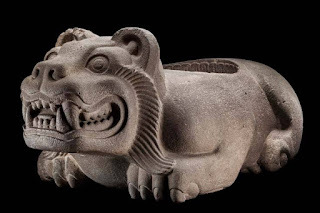
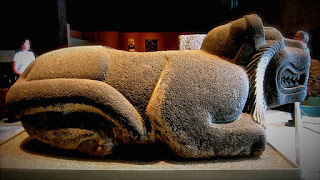 The two photos of the above-described Azteccuauhxicalli shaped like a mysterious ruffed cat (© Hodari Nundu/Anthropologyand History Museum, Mexico City – reproduced here on a strictly non-commercialFair Use basis for educational/review purposes only)
The two photos of the above-described Azteccuauhxicalli shaped like a mysterious ruffed cat (© Hodari Nundu/Anthropologyand History Museum, Mexico City – reproduced here on a strictly non-commercialFair Use basis for educational/review purposes only)
Icertainly do find it interesting. Although its ruff is seemingly lesspronounced than that of the skins procured by Sanderson (and its tail possiblylonger), this Aztec-sculpted creature certainly doesn't correspond to anycurrently-known Mexican felid, as noted by Hodari, and is yet another example,therefore, of a mystifying cat from this country that sports a very noticeableruff.
Butwhere is the mystifying ruffed cat today? I know of not a single modern-dayreport of a living cat fitting its instantly-recognisable description.
Howironic it would be if the skins encountered by Sanderson were from the verylast representatives of a felid so distinctive, and, seemingly, so greatlyfeared too, that in ages past humans had been sacrificed to a graven image ofit, but which had subsequently slipped into extinction before the modernscientific world had even had time to acknowledge its existence. From deity todeceased, in just a few centuries?
Besure to check out Parts 2 and 3 of this article, in which I document no fewerthan six additional feline cryptids of the lesser-known Mexican variety, when Ipost them on ShukerNature later this week.
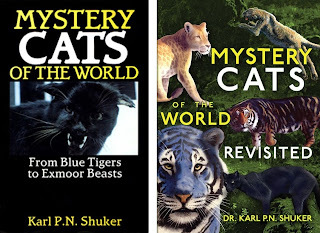 The two editions of my Mystery Cats of the World book (© Dr Karl Shuker/Robert HaleLimited/Coachwhip Publications)
The two editions of my Mystery Cats of the World book (© Dr Karl Shuker/Robert HaleLimited/Coachwhip Publications)
December 19, 2024
EVALUATING THE ELF CHIMP OF FLORIDA - GLOWING GREEN AND VERY MEAN!
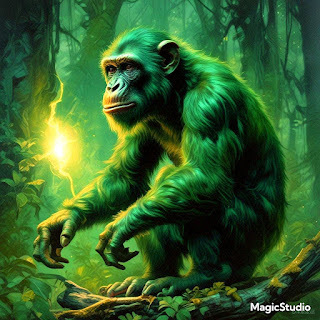 Isthis what the elf chimp looked like? (created by me using MagicStudio)
Isthis what the elf chimp looked like? (created by me using MagicStudio)My previous ShukerNature blog article wasdevoted to fictional green pigs (click here to read it), so now, continuingthis colourful theme, the current one presented here is devoted to a(supposedly) factual green chimpanzee.
As regular readers of my blog, books, andarticles will know well by now, I've always been attracted to the more unusual,little-known cryptids, and never more so than when they appear to be confinedto a single source, and with no apparent follow-ups either. So it was that when,many years ago, I read about the subject of this blog article of mine in justone solitary book and nowhere else, its details stayed in my memory, tofascinate but also frustrate me in equal measure. For in spite of havingsearched several times down through the years for additional information inother publications and widely online, I've never been able to uncover anyfurther details. Consequently, I've decided to present here in article form onShukerNature the scant details that I do have concerning what I have dubbed –for reasons explained later – the elf chimp of Florida, in the hope that myarticle might induce readers who may know more about this very curious cryptidto post their valuable information here.
My original – and only – source ofinformation (not counting, obviously, the numerous paraphrased versions of itthat have subsequently appeared in print and online) is John A. Keel's classicbook Strange Creatures From Time andSpace (USA 1970/UK 1976). A verbatim version of it later appeared in arevised edition of this book, published in 1994 and retitled The Complete Guide to Mysterious Beings.
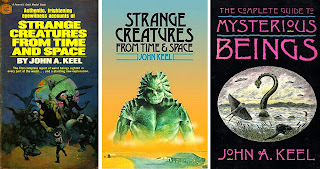 MyAmerican 1970 paperback, UK 1976 paperback, and American revised, retitled 1994paperback of the Keel-authored books noted above (© John A. Keel estate/FawcettGold Medal Books/Sphere Books/Doubleday Books – reproduced here on a strictly non-commercialFair Use basis for educational/review purposes only)
MyAmerican 1970 paperback, UK 1976 paperback, and American revised, retitled 1994paperback of the Keel-authored books noted above (© John A. Keel estate/FawcettGold Medal Books/Sphere Books/Doubleday Books – reproduced here on a strictly non-commercialFair Use basis for educational/review purposes only)
In both editions of Keel's book, therelevant excerpt appears as Case #15 within the Florida-themed section of achapter entitled 'Creatures from the Black Lagoon', and reads as follows:
"There's a terrible smellaround here. Can't you smell it?" the girl complained. She was one of fourteenagers parked in a Lovers' Lane near Elfers, [western] Florida, in January1967. As the others took deep breaths "an animal about the size of a largechimpanzee" sprang onto the hood [bonnet] of the car.
"Then we panicked!"the driver later told investigator Joan Whritenour. "The thing looked likea big chimp, but it was greenish [Keel'sitalics] in color, with glowing green eyes. I started the motor and the thingjumped off and ran back into the woods. We tore like blazes back to the dancewe were supposed to be attending."
A police officer from New PortRichey later visited the site and found a sticky green substance which remainsunidentified.
The investigator named in Keel's accountwas ufologist Joan Whritenour (who edited the ufological periodical Saucer Scoop). In 1967 she co-authoredwith famous mysteries researcher/writer Brad Steiger a book entitled Flying Saucers Are Hostile, followed ayear later by a second UFO-themed book, AllendeLetters. As I've never been a ufological researcher, however, I've neverowned a copy of either of these works, nor any issues of Saucer Scoop, so I have no idea whether they contain any mention ofthis case (although it's more cryptozoology-based than UFO-themed anyway). Consequently,could any ShukerNature readers who do own any or all of these publicationsplease check through them and let me know? Thanks very much! Sadly, neitherSteiger nor Whritenour are still alive, otherwise I'd have contacted them torequest further details regarding the 1967 Elfers incident.
Keel himself provided no primary sourcefor his above account's information, nor, as seen, did he attempt to assign anykind of identifying moniker to the green chimp (or chimp-like entity).Consequently, in order to make it more readily identifiable to and referable byfuture researchers, I have chosen to dub this creature the elf chimp – becauseit was seen near Elfers, and because the traditional elf-associated colour just so happensto be green.
 Theelf chimp was said to be greenish and to possess glowing green eyes (created byme using MagicStudio)
Theelf chimp was said to be greenish and to possess glowing green eyes (created byme using MagicStudio)
As a lifelong science-fiction movie buff(click hereto visit my film review blog, Shuker In MovieLand), when I read about thecreature's green colouration and the police officer's discovery of anunidentifiable sticky green substance at the site where the teenagers' encounteredit I readily recalled how such a substance, frequently some kind of deadlyradioactive spillage and/or of extraterrestrial origin, is a staple ingredientof sci fi-themed B-movies from the 1950s and 1960s. However, I personally doubtthat anything so (melo)dramatic was the identity of the green gloop in this reputedlyreal-life incident.
Shifting my attention to more prosaic possibilities,I recalled the many reported cases down through the years of so-called luminousowls, spied widely around the world, but especially in Europe, North America,and Australia – all regions that just so happen to harbour the pallid-plumagedbarn owl Tyto alba. Said to glow withintense brightness, sightings of mystery luminous owls have been discounted bysome scientists as observations of normal barn owls that have inadvertentlybrushed against bioluminescent fungi such as the honey fungus Armillaria mellea (which are sticky tothe touch, enhancing their adhesive capabilities) when perching in trees, withthese glowing fungi and their spores becoming attached to their feathers.Comparable fungi, including Armillariaonce again, also occur on the ground.
However, as swiftly pointed out byskeptics of this proposed solution, the total luminescence exhibited by acolony of such fungi in situ is still nowhere near as intense as has beenreported for a fair few luminous owls. This in turns means that even if barn owlsdid find themselves with some glowing fungal spores attached to their plumageafter having perched upon branches bearing them, the combined glow yielded bythese spores would obviously be less still than the total glow emitted by thecomplete colony of bioluminescent fungi on those branches.
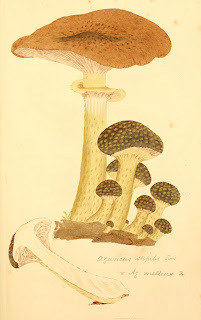 Honeyfungus Armillaria mellea, depicted ina vintage illustration from English naturalist/illustrator James Sowerby's Coloured Figures of English Fungi orMushrooms, 1789-1781 (public domain)
Honeyfungus Armillaria mellea, depicted ina vintage illustration from English naturalist/illustrator James Sowerby's Coloured Figures of English Fungi orMushrooms, 1789-1781 (public domain)
Consequently, I consider it highlyunlikely that even if it had climbed trees bearing glowing fungi and rolled onthe ground where glowing fungi were growing, the elf chimp encountered by theteenagers could have appeared greenish.
No details concerning the nature of thewoods from which it had emerged and back into which it had fled were includedin Keel's account, but I am wondering whether it contained any kind of largepool, pond, ravine, lake, stream, or some other body of freshwater. For if so,this might explain not only the elf chimp's colour but also its vile smell.Such bodies of freshwater in Florida and in many other localities around theworld all too regularly experience, especially during the summer months, thedetrimental phenomenon of algal blooms.
An algal bloom is defined as a rapidgrowth of microscopic true algae or of cyanobacteria in water, which oftenresults in a coloured scum appearing on the water surface. In marine bodies ofwater, these blooms are often red in colour, are caused by true algae, and someare known as red tides (but green ones also occur, depending upon the algalspecies involved), whereas in freshwater they are frequently bright green orbluish-green, and are caused by autotrophic gram-negative bacteria correctlyreferred to as cyanobacteria but which on account of their superficiallyalga-like outward appearance are popularly albeit inaccurately dubbedblue-green algae.
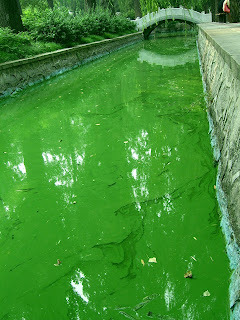 Abright green example of a severe freshwater algal bloom (public domain)
Abright green example of a severe freshwater algal bloom (public domain)
Algal blooms result when algae or cyanobacteria multiply quickly inwaterways with an overabundance of nitrogen and phosphorus (often caused byfertilizer having been dumped into them), particularly when the water is warmand the weather is calm. Moreover, they can have harmful effects upon thehealth of humans and other animals if water containing a bloom is touched, swumin, swallowed, or when airborne droplets are inhaled. They also emit a foul,putrid smell that can irritate, and they clog the gills of fishes swimming inwater polluted by them.
Florida's freshwater bodies areparticularly prone to algal blooms – indeed, in summer 2023 a toxic cyanobacterialbloom was covering roughly half of Lake Okeechobee, Florida's largest inlandlake (click here to access a news report concerningthis disturbing turn of events). In short, if the elf chimp had entered a bodyof freshwater containing a cyanobacterial bloom, whether deliberately oraccidentally, it could well appear greenish in colour, with the severeirritation to its skin conceivably explaining its belligerent behaviour, andthe stench emitted by the cyanobacterial bloom's scum even explaining thiscreature's awful stink as noted by the teenagers.
On the negative side of any explanation involvingalgal blooms is that the encounter took place in January, whereas these bloomsare most prominent during the warm, sunny summer months. Furthermore, if thebody of water where an algal bloom might potentially develop is ensconcedwithin a dark secluded forest with little sunlight penetrating through thetrees, this is far from ideal for a bloom's development, as the latter requiresplenty of sunlight to stimulate its growth via photosynthesis. And if thesticky green substance found at the site near Elfers by the police officer wereindeed from an algal bloom (or from glowing fungi for that matter), why couldit not be identified? Algal blooms (and glowing fungi) were already familiarphenomena, scientifically speaking, back then.
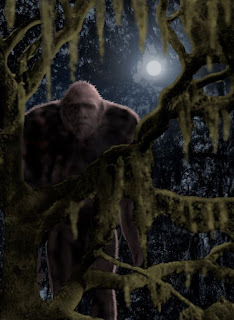 Artisticrepresentation of the Florida skunk ape (© William M. Rebsamen)
Artisticrepresentation of the Florida skunk ape (© William M. Rebsamen)
Also needing to be considered is whether,in spite of its eyewitnesses' likening it to, or even directly identifying itas, a chimpanzee, the creature really was a chimp. An absconded exotic pet oran escapee/release from a private collection or menagerie certainly offerplausible explanations for why such a creature might be existing in a woodlandnear Elfier. However, there is also the intriguing possibility that it may besomething truly cryptozoological – possibly a juvenile bigfoot, or, morespecifically, a Florida skunk ape.
The reason that I proffer this option forconsideration is that in the very same Florida-themed section of his book's'Creatures from the Black Lagoon' chapter, Keel included as Case #14 anotherencounter with a hairy green-eyed green-glowing foetid creature of unidentifiednature, but much larger than the elf chimp and more suggestive of a typicalbigfoot entity. Again, he provided no source for his information, but here ishow he described the encounter:
A young woman was changing atire on a lonely stretch of highway outside Brooksville, [western] Florida, onWednesday night, November 30, 1966, when she heard a noise in the bushes andbecame aware of a most unpleasant odor. Then a huge thing with large green eyeand an eerie greenish glow on one side of its hairy torso stood up beside theroad and studied her. She was terrified. The creature walked off into the woodswhen another car came along and stopped.
Worth noting here is that Brooksville andElfers exist in adjacent counties within western Florida, with Brooksville amere 38.7 miles north of Elfers.
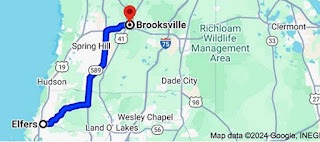 Mapshowing the proximity of Elfers to Brookesville, both situated in western Florida (© Google Maps– reproduced here on a strictly non-commercial Fair Use basis foreducational/review purposes only)
Mapshowing the proximity of Elfers to Brookesville, both situated in western Florida (© Google Maps– reproduced here on a strictly non-commercial Fair Use basis foreducational/review purposes only)
Partial but not full-body contact with ancyanobacterial bloom could explain why only part of the torso of theBrooksville beast was glowing green – as an adult (judging from its huge size),the creature would be more experienced and wary about immersing inbloom-polluted water than a juvenile would be. Of course, as with the elf chimpcase, the time of year in which this encounter occurred is outside the peaktime for algal blooms, but some can exist all year long. Alternatively, had oneside of its thorax simply brushed against some glowing fungi in theundergrowth?
Green glowing eyes have often beenreported in bigfoot sightings (so too have red glowing eyes). This suggeststhat whatever the species responsible, a tapetum lucidum, i.e. alight-reflecting cell layer, is present at the back of each eye, behind theretina, as is commonplace in nocturnal mammals, assisting these creatures tosee in dim light (by reflecting incoming light back out again through theretina, thus causing the reported glow or eyeshine).
However, as apes and monkeys are almostexclusively diurnal (only the Central and South American douroucoulis aka nightor owl monkeys are habitually nocturnal, as well as lower primates such aslemurs and lorises), their eyes do not possess a tapetum – indicating,therefore, that whatever it was, the elf chimp was not a true chimp.
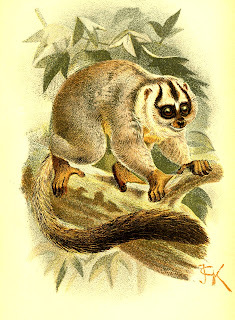 Adouroucouli depicted in an exquisite vintage illustration from 1894 by JohnGerrard Keulemans (public domain)
Adouroucouli depicted in an exquisite vintage illustration from 1894 by JohnGerrard Keulemans (public domain)
Having said that: an uncategorisedspecies of ape that has evolved to be nocturnal might be expected, therefore, tohave evolved such an adaptation. Again, the douroucoulis provide a precedenthere. For although they do not possess a true tapetum, i.e. composed ofriboflavin crystals (which nocturnal lemurs have), they do possess an analogousversion composed of collagen fibrils, indicating that their nocturnal lifestyleis a secondary adaptation evolved from ancestral species that were diurnal inlifestyle.
In short, glowing green eyeshine at nightdoes not necessarily rule out an ape identity for the bigfoot. Equally,however, those who favour a bear as this famous cryptid's true identity pointto the fact that bears' eyes do possess a true tapetum and shine at night, theprecise colour varying from red or orange to yellow or green, depending upon anumber of different factors (and thereby making conflicting reports of greeneyeshine and red eyeshine for the bigfoot less problematic).
As noted at the beginning of thisShukerNature blog article, I am unaware of any sequel to these cases, or theoriginal source material (newspaper reports?) upon which Keel based hisaccounts. Does any additional coverage exist, for example, that names theteenagers and/or the police officer, which could therefore enable them to betraced and interviewed if still alive? Gathering further first-hand eyewitnesstestimony from them might yield new, extremely valuable details. Someone withready access to the archives of local newspapers for Elfers and Brooksvillemight uncover such source material, which is why I have prepared this article –as a spur for further research by those better-placed geographically to conductit than I am, living in Britain. It would certainly be fascinating to knowwhether the elf chimp and its much larger green-furred Brooksville counterpartwere ever reported again, rather than being once-witnessed wonders of the kindall-too-frequently found hidden away in the cryptozoological archives.
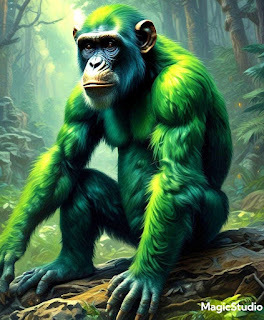 Theelf chimp – mean, green, and seen, but only once? (created by me using MagicStudio)
Theelf chimp – mean, green, and seen, but only once? (created by me using MagicStudio)
December 7, 2024
GREEN PIGS THROUGH THE LOOKING-GLASS - MUSING ON THE MOME RATHS AND OTHER CARROLLIAN CREATURES.
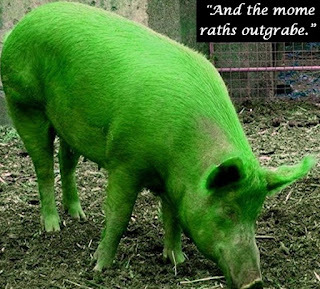 InLewis Carroll's Looking-Glass Land, mome raths are small green pigs with longsnouts (© Dr Karl Shuker)
InLewis Carroll's Looking-Glass Land, mome raths are small green pigs with longsnouts (© Dr Karl Shuker)Down through the years, I've documentedhere on ShukerNature, and subsequently in various of my books, a number ofmysterious creatures featured in certain famous works of literary fiction,investigating their possible origins, in particular the real-life animals thatmay have inspired their creation.
Such book-dwelling beasts chronicled byme include (but are by no means limited to): the Cheshire cat and the mockturtle from Lewis Carroll's classic children's book Alice's Adventures in Wonderland (click here and here to read my respective accounts ofthem); the tiny but deadly snakeling Karait from Rudyard Kipling's stand-aloneshort story 'Rikki-Tikki-Tavi' (click here); the rather larger but no lesslethal Indian swamp adder (aka the Speckled Band) and the giant rat of Sumatraconfronted by the great detective Sherlock Holmes (click here and here); the dream-like hound of thehedges from Charles G. Finney's celebrated fantasy novel The Circus of Dr Lao (click here); the wild were-worms of the LastDesert as referred to by Bilbo Baggins in J.R.R. Tolkien's The Hobbit (click here); Sir Arthur Conan Doyle's huge Brazilianblack cat (click here); Ron Weasley's giant spidernemesis in a Harry Potter novel (click here); plus a veritable menagerie ofscientifically-unrecognised fauna, from a purple bird of paradise and giganticluna moths that really are from the moon to some shy living dinosaurs, a giantpink sea snail, and the incredible bicranial pushmi-pullyu, all inhabiting the delightfulDoctor Dolittle novels written by Hugh Lofting (click here, here,and here).
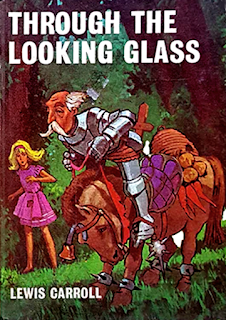 The1969 Bancroft Classics #47 hardback edition of Through the Looking-Glass that I owned as a child (© Bancroft Books– reproduced here on a strictly non-commercial Fair Use basis foreducational/review purposes only)
The1969 Bancroft Classics #47 hardback edition of Through the Looking-Glass that I owned as a child (© Bancroft Books– reproduced here on a strictly non-commercial Fair Use basis foreducational/review purposes only)
As it's been a quite while since I lastwrote about any such literary cryptids, however, I feel that it's high time Idid so again – and what better source to choose from than Lewis Carroll'ssecond Alice book, Through theLooking-Glass, and What Alice Found There (to give it its full title),which was published in 1871, six years after Alice's Adventures In Wonderland. As a child I enjoyed this sequelnovel even more than the original, afore-mentioned Alice book, because itsstoryline and characters were far less familiar to me.
In particular, I was fascinated by thepoem 'Jabberwocky', one of the world's best known nonsense poems. Aliceencounters it quite early in Through theLooking-Glass, but as it is written in mirror-image format, she initiallyfinds its verses difficult to read. Moreover, even when she is able to readtheir reflection in the titular looking-glass, she still cannot understand thembecause she discovers that they are packed with bizarre made-up words – wordsthat confused but captivated me just as much as they did with Alice, until sheencountered the nursery-rhyme character Humpty Dumpty, a self-proclaimedetymological expert, who explained many of them to her.
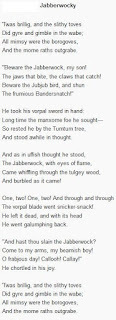 Thefull version of Lewis Carroll's self-penned nonsense poem 'Jabberwocky', asfeatured in his second Alice novel, Throughthe Looking-Glass and What Alice Found There – please click this poem'spicture here to enlarge it for reading purposes (public domain)
Thefull version of Lewis Carroll's self-penned nonsense poem 'Jabberwocky', asfeatured in his second Alice novel, Throughthe Looking-Glass and What Alice Found There – please click this poem'spicture here to enlarge it for reading purposes (public domain)
Moreover, the latent cryptozoologiststirring within me even as a youngster meant that I was additionally fascinatedby this poem's tantalizingly brief, ambiguous references to a number ofstrange-sounding beasts that seemed endemic to Looking-Glass Land – creatureslike the slithy toves, for instance, or the bandersnatch, the borogoves, themome raths, and, needles to say, the eponymous monster itself, the jabberwock.Some of these were succinctly described by Humpty Dumpty, but others were not,thereby remaining enigmatic and elusive. Consequently, down through the yearsmy childhood memories of this poem have inspired me to seek out furtherinformation concerning its fabulous if fictitious fauna in the hope ofdetermining what kinds of creatures they were – and here is what I've foundout.
As Humpty Dumpty explained to Alice, manyof those weird words in 'Jabberwocky' are portmanteaus, i.e. they have beenformed by combining two or more separate, well-known words together to yield atotally new albeit far less familiar one. 'Slithy', for instance, arises fromthe combination of 'slimy' and 'lithe', 'frumious' from 'fuming' and 'furious','mimsy' from 'flimsy' and 'miserable', 'chortled' from 'chuckled' and'snorted', and so forth (Humpty Dumpty elucidating most of these for Alice). Thenthere are some that are simply extrapolations from existing words, such as 'beamish',defined by Carroll as beaming radiantly with joy or happiness (though,interestingly, scholars have subsequently discovered that this is onepeculiar-sounding word in 'Jabberwocky' that Carroll did not invent, its usagehaving been traced back as far as 1530).
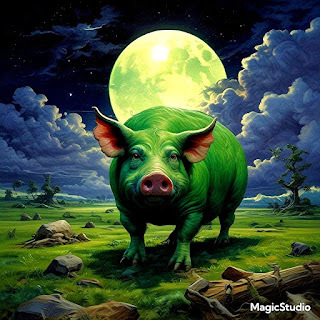 Achortling mome rath beneath a beamish moon!
Achortling mome rath beneath a beamish moon!
For the most part, however, such forms ofword derivation do not assist in revealing the respective natures of thevarious anomalous animals mentioned in 'Jabberwocky'. Consequently, it is fortunatethat between Humpty Dumpty's in-book revelations, the accompanyingillustrations prepared by Sir John Tenniel (who had previously prepared thosethat had illustrated the first Alice book), and various explanatory notes madeby Carroll in a publication that preceded Throughthe Looking-Glass's first printing by almost 20 years, much of the mysterysurrounding them can be dissipated.
The publication preceding Through the Looking-Glass was aperiodical entitled Mischmasch,written and illustrated by Carroll himself, which was published in 1855. It washere in which the original, significantly shorter version of 'Jabberwocky'first appeared, consisting of just the first verse of what would subsequently becomethe full multi-verse version in Throughthe Looking-Glass, published 16 years later. Needless to say, therefore, asthe jabberwock itself is not actually mentioned in the first verse, thatoriginal single-verse version was not titled 'Jabberwocky'. Instead, Carolldubbed it 'Stanza of Anglo-Saxon Poetry'. And as will be seen, it is veryintriguing how Carroll's concept of what some of his fictional creatures looklike changed quite dramatically from his descriptions of them in thisperiodical to his descriptions of them (as verbalized via Humpty Dumpty) in thenovel.
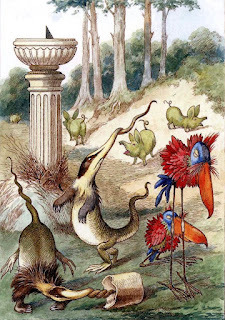 Avintage colorized version from 1927 of Tenniel's illustration depicting some ofthe cryptic creatures alluded to in Carroll's poem 'Jabberwocky' - the two badger-faced animals withcorkscrew-shaped muzzles and webbed feet are toves; the two long-legged birds(one of them is kneeling with legs bent) are borogoves; and the four smalllong-snouted pigs are mome raths (green in colour, according to Humpty Dumpty,hence tinted here accordingly), of which three are in the foreground above thetoves and borogoves, with the fourth one just visible in the background to theleft of the sundial) (public domain)
Avintage colorized version from 1927 of Tenniel's illustration depicting some ofthe cryptic creatures alluded to in Carroll's poem 'Jabberwocky' - the two badger-faced animals withcorkscrew-shaped muzzles and webbed feet are toves; the two long-legged birds(one of them is kneeling with legs bent) are borogoves; and the four smalllong-snouted pigs are mome raths (green in colour, according to Humpty Dumpty,hence tinted here accordingly), of which three are in the foreground above thetoves and borogoves, with the fourth one just visible in the background to theleft of the sundial) (public domain)
So let's begin our annotated checklist ofthe 'Jabberwocky' wildlife. The creatures first mentioned in it are the slithytoves, which as noted earlier are apparently slimy and lithe, and are thesubjects of the most detailed description of any creature name-checked in thepoem. According to Humpty Dumpty:
Toves are something likebadgers, they're something like lizards, and they're something likecorkscrews...Also they make their nests under sun-dials, also they live oncheese.
And that is still not all. For as notedin the poem, they "gyre and gimble in the wabe", which as defined byHumpty Dumpty means that they go round and round like a gyroscope, and boreholes like a gimlet. As for the wabe, he states that this is the grass plotaround a sundial (where the toves make their nests) and is so named because it"goes a long way before it, and a long way behind it".
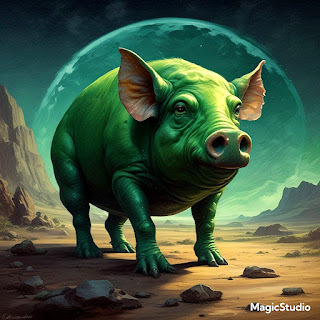
 Onlyin Looking-Glass Land – a green pig beneath a blue moon!
Onlyin Looking-Glass Land – a green pig beneath a blue moon!
Conversely, back in 1855 Carrolldescribed the toves quite differently in Mischmasch,stating that they were "a species of Badger [which] had smooth white hair,long hind legs, and short horns like a stag [and] lived chiefly on cheese".Moreover, rather than defining the wabe as the grass plot around a sundial, heclaimed that it was the side of a hill.
Moving on to the borogoves, they aredescribed merely as mimsy in the poem itself, which as we have seen earlierindicates that they are flimsy and miserable. However, Humpty Dumpty expandsupon this briefest of accounts by stating that a "borogove is a thinshabby-looking bird with its feathers sticking out all round, something like alive mop". Tenniel's picture illustrates them as vaguely stork-like, withvery long legs (one of them is kneeling, so its lengthy legs are largelyconcealed beneath its body). Conversely, again, in his Mischmasch periodical Carroll had described this species as: "Anextinct kind of Parrot. They had no wings, beaks turned up, and made theirnests under sun-dials: lived on veal". Interestingly, therefore, it wouldappear that when writing Through theLooking-Glass, Carroll transferred to the toves the distinctive habit ofmaking their nests under sundials that he had originally attributed in Mischmasch to the borogoves.
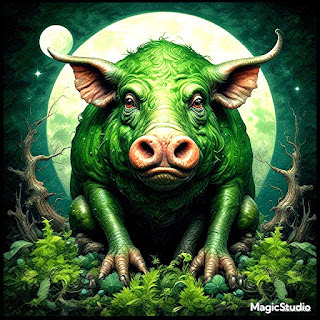 Youlookin' at me? Is this mome rath feeling rather wrathful?
Youlookin' at me? Is this mome rath feeling rather wrathful?
Now we come to my favourite members ofthe 'Jabberwocky' zoo (though you've probably already guessed that, by virtueof their pictorial preponderance in this blog article!). Namely, the momeraths. Humpty Dumpty merely describes them as "a sort of green pig",whereas in perhaps his single most dramatic change of identity for any animal referredto in this poem, Carroll stated in Mischmasch:
'Rath' is "a species ofland turtle. Head erect, mouth like a shark, the front forelegs curved out sothat the animal walked on its knees, smooth green body, lived on swallows andoysters.
Transforming from a green land turtle toa green pig in just 16 years is quite a metamorphosis, that's for sure! Havingsaid that, I personally consider a small long-snouted green pig to be a muchmore delightful concept than a shark-mouthed, knee-walking land turtle,green-coloured or otherwise. And speaking of long-snouted: Tenniel appears tohave been wholly responsible for giving that particular characteristic to thequartet of mome raths depicted by him, an example of artistic licence, perhaps,as it certainly does not feature in either of the verbal portraits quoted abovefor this porcine species.
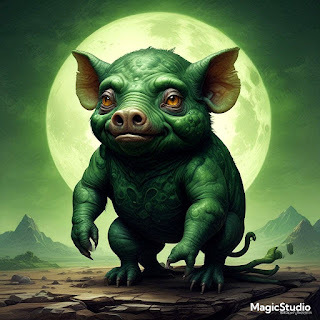 Amome rathlet (or green piglet, if you prefer!) – how cute is that??
Amome rathlet (or green piglet, if you prefer!) – how cute is that??
Perhaps the most unexpected of allportrayals of the mome raths, however, appears in Walt Disney's classic 1951animated feature film Alice in Wonderland.One rather sad, downbeat scene features a tearful Alice having inadvertentlybecome lost in the dark, forbidding Tulgey Wood, home of the jabberwock (butnever seen in this movie version). Suddenly, a voice breaks the somberstillness, warning Alice somewhat peremptorily not to step on the mome raths.Shocked, she looks down, and there all around her are small entities resemblingflowers but walking on two tiny legs. These very atypical mome raths dulyassemble themselves in various shapes, culminating in a large arrow that pointsto the route leading out of Tulgey Wood, which a very thankful Alice swiftlyfollows. Although these floral mome raths are certainly endearing (albeitinexplicable!), I feel that some animated green pigs would have been moreappealing to this movie's viewers, as well as being far more in-keeping withits somewhat psychedelic visuals.
But now to the descriptive component ofthis creature's name – from where is the 'mome' in 'mome rath' derived? Here,for the first time, we find little (if any) satisfactory explanations. Even theetymological egomaniac that is Humpty Dumpty confesses to Alice that he isuncertain regarding the derivation of 'mome' – an admission indeed! – offeringonly this vaguely hopeful suggestion: "I think it's short for 'from home',meaning that they'd lost their way, you know". Rather like Little Bo Peep'ssheep, then? As for 'rath': whenever I read 'Jabberwocky' as a child, 'rath'always reminded me of the word 'rasher' – who knows, perhaps I was ontosomething!
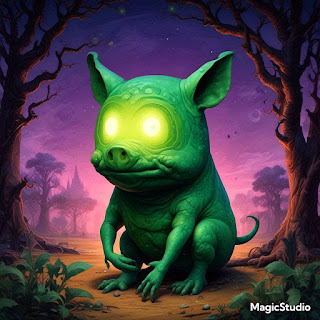
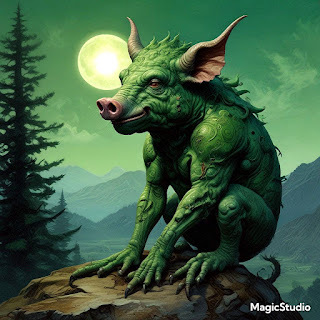 Acouple of seriously strange mome raths!
Acouple of seriously strange mome raths!
And with regard to this poem's claim that"the mome raths outgrabe", Humpty Dumpty reveals that"'outgribing' is something between bellowing and whistling, with a kind ofsneeze in the middle" (with 'outgrabe' being the past tense of 'outgribe').So now we know!
Moving now into the second verse of'Jabberwocky', it includes three more mystery beasts, the first, and also theforemost, of these being this poem's eponymous beast itself – the jabberwock. Yetin spite of its being the title character, very little descriptive informationis provided for this monster. It is said to have "jaws that bite" and"claws that catch", which apart from confirming that it does indeedpossess these particular anatomical accoutrements is of very little use,bearing in mind that their respective, exceedingly succinct one-verbdescriptions fit the activity of the jaws and claws of most animals thus equipped.
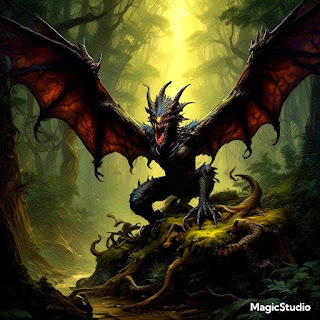 "Bewarethe Jabberwock, my son!"
"Bewarethe Jabberwock, my son!"
The only other details provided are the statementsin the fourth verse that the jabberwock has "eyes of flame", that it"came whiffling through the tulgey wood", and that it"burbled". The first statement is self-explanatory, and so, in asense, is "whiffling" – for instead of being a Carrollian invention,this is a real word whose usage can be traced back as far as 1568, and isdefined in the Merriam-Webster Dictionaryas emitting or producing a light whistling or puffing sound. As for"burbled", Carroll stated in a letter dating from 1877 (six yearsafter Through the Looking-Glass waspublished) that he didn't remember creating it, but surmised that it may be acomposite of 'bleat', 'murmur', and 'warble'. Interestingly, 'burble'subsequently entered the English language as an accepted word, and today isdefined in the Merriam-Webster Dictionaryas a verb that means to make a bubbling sound, and also to babble or prattle,plus a noun that means prattle. So, surprisingly, it looks like when ponderingthe origin of 'burble', Carroll didn't consider two words that seem much morelikely to have been bona fide components of it, namely 'bubble' and 'babble',than either 'bleat' or 'murmur' (though his third proposed component, 'warble',does still seems promising as a contender in this capacity).
Due to the scarcity of morphologicaldetails provided in thje poem, Tenniel was evidently given free rein whenpreparing his detailed full-page illustration of the jabberwock, which isreproduced in vintage colorized form below. As can be seen, Tenniel's terror isa most curious creature – combining a very lengthy elongate neck and tail, apair of insect-like antennae, and a pair of catfish-like mouth barbels withhuge bat-like wings, long bushy side-whiskers, and the incisors of a rabbit,plus, just for good monstrous measure, no doubt, it is wearing a very natty waistcoat!
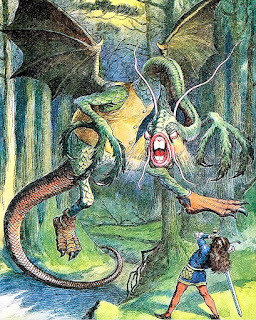 Vintagecolorized version of Tenniel's original illustration of the jabberwock, from Through the Looking-Glass (publicdomain)
Vintagecolorized version of Tenniel's original illustration of the jabberwock, from Through the Looking-Glass (publicdomain)
The other two mystery beasts name-checkedin the second verse are the jubjub bird and the frumious bandersnatch. Nodetails whatsoever are given in it regarding the jubjub bird, but as the fatherin the poem tells his son to beware both of these entities, we must assume thatthey were dangerous ones. The only additional clue regarding the bandersnatchis Carroll's use of the portmanteau adjective 'frumious' to describe it. Thisis a word that Carroll deferred from defining until a few years later, in thepreface to his lengthy stand-alone nonsense poem The Hunting of the Snark, published in 1876, and in which both thejubjub bird and the bandersnatch reappear. Two of this latter poem's maincharacters hear the jubjub bird's very scary cry (described as a shrill andhigh scream), whereas a third main character is attacked by the bandersnatchand is driven insane after trying to bribe it. In this composition's preface,Carroll states that 'frumious' is a composite of 'fuming' and 'furious', soclearly the bandersnatch is a beast best avoided!
Meanwhile, here is a very charming butsomewhat idiosyncratic illustration from 1902 depicting the jubjub bird and thebandersnatch, prepared by Peter Newell (1862-1924), an American artist andwriter of children's books, in which neither of these creatures seems even remotelybelligerent, let alone frumious:
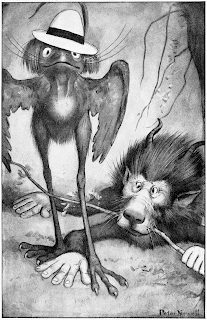 Illustration of the jubjub bird and the bandersnatch by PeterNewell in a 1902 edition of Through theLooking-Glass (public domain)
Illustration of the jubjub bird and the bandersnatch by PeterNewell in a 1902 edition of Through theLooking-Glass (public domain)
No further creatures appear in'Jabberwocky', but those that are present there have frustrated and fascinatedgenerations of readers eager to learn more about them, and no doubt willcontinue to so for the foreseeable future.
Except for this ShukerNature blogarticle's opening photograph of a mome rath, which I created by digitallymanipulating a public-domain stock photo of a typical shorter-snouted pink porker, all mome rath illustrations included here (as well as the firstjabberwock illustration) were created by MagicStudio.
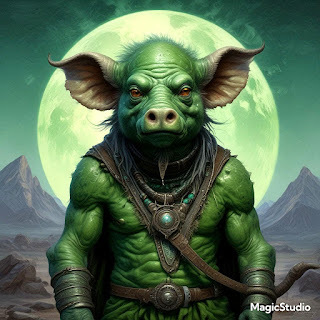
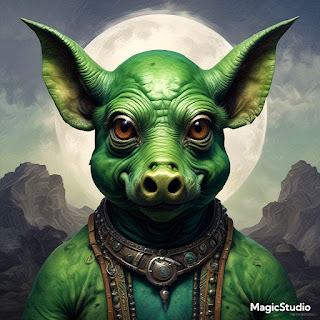 Ina mome rath galaxy far, far away, Throughthe Looking-Glass meets The Lord ofthe Rings, or could it be Planet ofthe Pigs?
Ina mome rath galaxy far, far away, Throughthe Looking-Glass meets The Lord ofthe Rings, or could it be Planet ofthe Pigs?
November 30, 2024
FINDING THE FEATHERED LIONS OF LARRY HAGMAN – AGAIN!
 DidAmerican actor Larry Hagman see something like this during his 'trip'?
DidAmerican actor Larry Hagman see something like this during his 'trip'?My memory has always been akin to anexceedingly eclectic but generally well-organised, well-maintained filingcabinet whose innumerable drawers contain all of the myriad facts that I'veacquired throughout my life, including the 40 years that I've spent researchingand writing about cryptids, mythological beasts, and fantastical fauna (flora too)of every imaginable, and unimaginable, kind. Occasionally, however, a fact filesomehow becomes misplaced, misfiled, or just plain missing. And so it was withthe slim but stimulating file of the feathered lions.

Quite a few years ago now, I distinctlyremember reading about some celebrity's autobiography in which he'd referred inpassing to some feathered lions – enough in itself to attract my attention andthereupon file away this intriguing snippet for some future use. As the yearspassed by, however, and it remained unused and unreturned to by me, its detailsbegan to fade from my mind. Still, not to worry, I thought, I have it filedsafely away in my physical archives as well as in my cerebral ones – until,that is, the subject came to mind again earlier this week, prompting me to seekout the relevant information in my archives and write it up at long last forShukerNature. But could I find it? Not a chance!

Moreover, by now no longer able even torecall who the celebrity was in whose autobiography these ethereal entities hadappeared, there seemed no chance of tracking anything down (online searches drewa blank). So I finally abandoned the subject, and started looking up a totally differentone instead – at which point the Library Angel, aka the Seraph of Serendipity,clearly took pity on me, as has happened so many times in the past, to my undyinggratitude.
 Ifsuch an exotic creature as a feathered lion existed, what a spectacular sight itwould be!
Ifsuch an exotic creature as a feathered lion existed, what a spectacular sight itwould be!
Opening on my laptop acryptozoology-themed folder of chronologically-arranged files consisting of reports,articles, and other info downloaded by me from the Net during the year 2016, Istarted looking for the file that I needed for my new investigation, but therewere a very sizeable number of files in it, and I had no idea of the specificdate on which I'd downloaded the file in question. So I automaticallyrearranged all of that folder's files into alphabetical order instead, by filetitle, hoping to spot the file quickly by way of its title's subject. Thetitles were organised into columns, and while casually casting my eyes across anddown a few of these columns before beginning the full painstaking scrutiny ofeach file title in each column, my eyes alighted upon one particular filetitle, and opened wide as they did so – 'Larry Hagman sees feathered lions'! Ofcourse – Larry Hagman! Even before opening the long-overlooked file, its titlealone was sufficient to usher forth the basic information that it contained,but obviously I still opened it anyway. And here is what I read.

The relevant information had appeared ina posthumously-published newspaper article recalling some of the wild eventsfrom Hagman's life that he'd documented back in his 2001 autobiography HelloDarlin': Tall (and Absolutely True) Tales About My Life. Hagman had ofcourse been an American actor best known for his role as astronaut Tony Nelsonin the 1960s fantasy comedy TV show IDream of Jeannie; and, above all else, for his globally-acclaimed tour de forceas ultra-villainous oil baron J.R. Ewing in the glossy mega-successful Americansoap Dallas, originally running fromthe late 1970s to the late 1980s, then revived in various spin-offs that begana decade later.
 A multicolouredmonarch of all that he surveys!
A multicolouredmonarch of all that he surveys!
The newspaper article had been publishedback in 2012 (thus explaining why I'd not thought to look for it in the 2016folder, the reason why it was in there and not in the 2012 folder being thatI'd only learnt about this article and downloaded it on 7 June 2016, but I'dlong since forgotten that small yet crucial fact!), by London's Daily Mail, on, of all days, 9 December(my birthday!), which was just over a fortnight after Hagman had passed away,on 23 November 2012.

Anyway, reading through this article ittranspired that some time prior to 2001, feeling very stressed after alwayshaving been a total workaholic and perfectionist had eventually taken asizeable toll upon his emotional well-being (a situation exacerbated after he hadperhaps unwisely also decided to give up two longstanding vices – smoking and slimmingpills – on the very same day), Hagman had sought aid, advice, and assistancefrom all quarters. Two years after his issues had begun, however, one of thosehe'd consulted now suggested that perhaps he should "drop some acid",i.e. try taking some tabs of the potent hallucinogenic drug LSD.

Although Hagman initially dismissed thisidea, it became firmly lodged in his mind, until eventually he gave intotemptation, and obtained some pure LSD tabs from none other than the lateAmerican rock singer/songwriter David Crosby, of Crosby, Stills and Nash fame,after he'd attended one of their concerts and had gone backstage to meet them afterwards.Even so, it still took Hagman a month before he finally summoned up the nerveto take one, and thereby experience his first trip. Here is how he describedit:
Just a few moments after I'dswallowed a tab, part of the room I was in became a cave that was guarded bytwo feathered lions as well as octopus-like creatures with long, writhing tentacles.
So there it is, such that it is – the onlysource of information regarding feathered lions that I've ever encountered, froma most unlikely source, and generated in a very unexpected fashion. Although itmay not contribute greatly to our shared global lore on fantasy beasts, it is nothingif not interesting, and memorable – which is why it has compelled me to track itdown almost a decade later, and document here on ShukerNature the exotic creaturesmentioned in it.
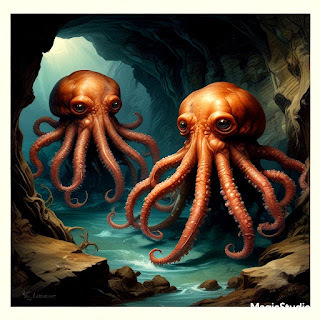 Cave-dwellingctopus-like creatures also featured in Hagman's drug-induced hallucination
Cave-dwellingctopus-like creatures also featured in Hagman's drug-induced hallucination
Finally: all of the very eyecatching illustrationsof feathered lions and cave-dwelling octopuses included here were created by mespecially for this article yesterday, utilizing the MagicStudio image-generationprogram.

November 1, 2024
PUTTING THE QUEENSLAND TIGER AND THE CONGOLESE WATER ELEPHANT IN THE PICTURE!
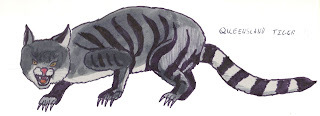 Myillustration of the Queensland tiger aka the yarri, which I prepared as ateenager back in the mid-/late1970s (© Dr Karl Shuker
Myillustration of the Queensland tiger aka the yarri, which I prepared as ateenager back in the mid-/late1970s (© Dr Karl ShukerSerendipity has played a big part in mylife, usually involving my looking for one thing and, while doing so, findingsomething entirely different but equally worthwhile. And so it proved againtoday.
As a teenager during the mid-/late 1970s,I'd written a letter to Prof. Christopher Evans, a very notable Welsh scientistand psychologist who at that time was also acting as scientific advisor for ITV'shit British teenage-oriented sci fi TV show TheTomorrow People. My letter concerned a biological subject touched upon notonly within one of this show's series but also, and this time in much moredetail, within an episode of the original, classic Star Trek TV show. I didn't really expect to receive a reply, as Iassumed that he must receive countless letters from fans of the show, so I wasboth surprised and delighted when I did indeed receive one, in the form of acharming, insightful letter from the man himself, which I greatly treasured –and especially so when Prof. Evans tragically died not long afterwards, of cancer,in 1979, aged only 48.
It occurred to me recently that I soughtto scan this precious letter from Prof. Evans and post it here on ShukerNaturewith the background details leading up to it, thereby preserving it publiclyfor posterity. So today I sought out the folder in which I always believed itto have been placed by me long ago for safekeeping – only to realize to myhorror when searching for it that I no longer had any idea where said folderwas! After several hours, however, I finally uncovered it – only to discoveronce again to my horror that it did not contain said letter! So now I have tostart searching all over again for it.
However, in that very same folder I didfind two other items that caught my attention, both of which I'd hithertoentirely forgotten – a pair of colour illustrations of two mystery mammals that I'd prepared atmuch the same time that I'd written my letter to Prof. Evans, meaning that theyare almost 50 years old and have never been seen outside that folder – untilnow. For although I freely confess that my artistic attempts fall far short ofthose wonderful artworks created by my various bona fide artist friends onsocial media and elsewhere, as they nonetheless constitute one of my earliestforays into creating cryptozoological output I felt that followers of myShukernature blog might like to see them, and also it means that they are now atleast for the present preserved online. So here they are.
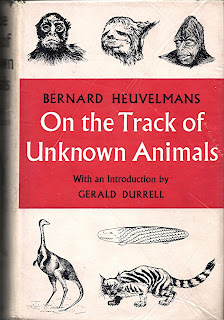 Mycopy of the hardback First Edition of On theTrack of Unknown Animals, by Dr Bernard Heuvelmans, featuring several line illustrationsby Monique Watteau on its dustjacket, including her rendition of the Queenslandtiger (© Dr Bernard Heuvelmans/Monique Watteau/Rupert Hart-Davis – reproduced hereon a strictly non-commercial Fair Use basis for educational/review purposes only)
Mycopy of the hardback First Edition of On theTrack of Unknown Animals, by Dr Bernard Heuvelmans, featuring several line illustrationsby Monique Watteau on its dustjacket, including her rendition of the Queenslandtiger (© Dr Bernard Heuvelmans/Monique Watteau/Rupert Hart-Davis – reproduced hereon a strictly non-commercial Fair Use basis for educational/review purposes only)
The first one, opening this particular blogpost, is my colour illustration of Australia's elusive Queensland tiger oryarri (documented by me here on ShukerNature), which wasinspired by a b/w line drawing prepared by French artist Monique Watteau thatappeared in veteran cryptozoologist Dr Bernard Heuvelmans's seminal tome On the Track of Unknown Animals (1958).In addition, when I prepared my above illustration, I had never encountered afull-colour image of the Queensland tiger anywhere, so mine may actually havebeen the very first one prepared (but don't quote me on this, just in case!).
The second one, posted below, is ofAfrica's enigmatic Congolese water elephant (documented by me here on ShukerNature), which I recallbeing inspired by another original line drawing in a publication, but I haven'tbeen able to trace which one. I thought that it was another Watteau lineillustration from Heuvelmans's afore-mentioned book, but I cannot find any suchimage in it.
Anyway, I hope that you enjoy viewingthem here. Meanwhile, my search for the lost letter from Prof. Evans continues…
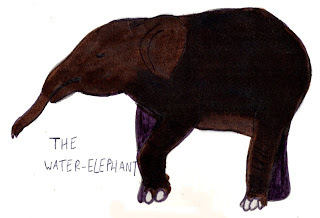 Myillustration of the Congolese water elephant, which I prepared as a teenagerback in the 1970s (© Dr Karl Shuker
Myillustration of the Congolese water elephant, which I prepared as a teenagerback in the 1970s (© Dr Karl Shuker
Karl Shuker's Blog
- Karl Shuker's profile
- 45 followers



